Foreword
Analysis of family businesses, as well as research into issues that may not only be unique to the family business concept such as diversification, succession and corporate governance, to name a few is not a new practice, but rather a well established practice from both, an academic as well as a practical perspective. Within this study, the main aim is to establish the effect of previously mentioned processes with specific emphasis upon diversification in the family businesses, as well as the resulting effect or effects, brought about by such strategic decision making and diversification processes.
A combination of primary and secondary research helped assessing these effects, as well as the consequences whether based on a positive or negative outcome, in addition to the various findings or inactions that were brought about by the primary research sampling, on the managerial level and the strategic direction of the companies concerned.
Based upon the fact that a family business concept is quite often a private or closely held affair, market research proves to be somewhat difficult in obtaining adequate contribution and clear responses in certain areas. However, the sampling within the primary research data is deemed to be sufficient in establishing an overall commonality or differences where applicable.
Specific issues pertaining to the sampling laid out according to the findings, with the summary providing an insight into lessons learned from the diversification process, as well as processes that become necessary on a post-diversification basis, have had to be implemented by the companies concerned to ensure continuity, succession, governance and adherence to the legal and operational frameworks where applicable.
Executive Summary
The rationale of the study was to analyze how does the decision to diversify family businesses impact the long-standing family business, providing the current formation/structure of the business from a legal perspective, as well as thoughts and impressions of the business ownership to the process of diversification, based upon the overall negative or positive result of pursuing such strategic decisions.
Although an average market response was received, the size and response of the sampling is sufficient to establish a certain median within the questions posed, and in turn, displaying sufficient results and patterns.
On the basis of post-analysis, a number of interesting issues surfaced which could have been included within the primary data collection phase, such as that of succession. However, a significant amount of research has already been conducted on this topic and is expanded upon both in the secondary data discussion, as well as the lessons learned, which can, furthermore, be stressed and considered by family businesses in their planning, not only for continuity but to achieve sustainability as well. These issues are further investigated by that of corporate governance or the lack thereof, of which is highlighted within the document in hand.
Hypothesis Statement
What are the effects of the previously mentioned processes with specific emphasis upon diversification in family businesses and the effects due to the strategic decision making and diversification processes?
Tools Used in Research
For this study, a web based survey has been designed using Survey Monkey. Survey Monkey helps not only in designing a survey with multiple options, but it also allows the user to send the survey to respondents by email. User can also publish the designed survey on networking sites like Facebook, etc. Another good feature offered by Survey Monkey is the result evaluation by the mean of graphical presentation and charts. These features helped a lot in evaluating survey results in the best possible way.
Introduction
This study involves analysis of family businesses, as well as the research over the issues that may not only be unique to the family business concept such as diversification, succession and corporate governance. Investigation not only involves the academic aspect of the topic but would also explore the practical perspective of the same. This study aims to establish the effects of previously mentioned processes with specific emphasis upon the diversification in family businesses, as well as the resulting effect or effects of the strategic decision making and the diversification processes.
The research side of this paper involves both, the primary and secondary data so that the effects of research and its implementation are assessed in the best possible way. This study also involves analysis of the consequences for the companies to rectify the managerial level and strategic direction of the companies concerned.
Literature Review
This section of the dissertation involves review of several term papers, researches, articles and journal, etc. As discussed above, this study involves primary and secondary data. Primary data is the unprocessed data, obtained via research. While secondary data is processed data, this could be a term paper, dissertation, article, journal, blog or any other piece of work that is written by someone and is based on some research. Methodology of any study involves two main sections. The first one is the literature review while the other one is the real research.
Summary of the Secondary Data
Secondary data of this study involves the relevant literature that is obtained and accessed via published journal articles, books and other available media items. All papers that have been utilized in this study are not only relevant to the diversification process and its impact upon the family business, but also to numerous other factors that come into play, as the business progresses in the form of growth, expansion, as well as the resource management and ultimate issues that affect the continuity of the business, which is somewhat more prevalent within the family business circumstances.
Additional factors that also engage a role within the business itself is the family relationship dynamic and how these dynamics play out within a business environment, whereby the family members may or may not associate their familial relationships within the business environment.
These factors are mostly discussed and investigated in the analysis, however, the literature has been analyzed with certain elements and conditions that came into light which require further exploration as they play a role within the specifics of the family owned and or controlled businesses under scrutiny.
Additional research possibilities and opportunities exist albeit on a secondary basis, via the internet, as well as published sources. The information that is highlighted here is selected in accordance with boundaries of the diversification process and the impact upon a family owned company, more importantly on well established family businesses, as per the research subject matter. One has to furthermore bear in mind that the family business is subject to additional “phenomena”, that may not be relevant to other companies, such as succession strategies, as well as the handling of internal family affairs and the resulting benefits or disadvantages thereof.
A number of statistics regarding the family business are well worth mentioning here, in order that one may gain an understanding of the large contribution that family businesses across the world actually provide within their respective locations. With respect to the additional research into the family business or organization, the family owned and controlled businesses are in fact the predominant form of business within the United States, yet a remarkably low level of research into these entities has been conducted, and furthermore, the authors claim that the ownership and management of the firms are widely separated (Phan & Butler 2008), which as revealed within the primary market research is not the case. The respondents within the study revealed that some sort of involvement whether via management or leadership had continued within the organization in one form or another.
A Look at “The Top One Hundred Oldest Family Businesses”
A closer look at the family business reveals that many companies that are now publicly listed may well have started off as a family business. O’Hara provides in his analysis of the top one hundred oldest family businesses, a variety of geographically located companies that operate in just diverse sectors and fields. In terms of these companies many internationally recognized brands and names are represented, the likes of which include that of Reidel Glassmakers, Villeroy & Boch, Taittanger, and Antinori. Interestingly, analysis of the descriptions of the companies as well as their development reveals that many of these companies underwent some sort of diversification from product offering expansion, to geographical diversification to that of mergers and acquisitions, to create companies that are established in modern day economies. A brief analysis of O’Hara’s data and research is pertinent due to the relevancy of the topic at hand; it further provides an insight into the international viewpoint of the family business as well as location and subsequent developments of these very old family owned businesses (O’Hara n.d).
The geographic dispersion of these companies is interesting as one will realize a trend in countries which have the most representation of these companies. The illustration below reflects the geo-location, by country of some of the world’s oldest family owned companies.
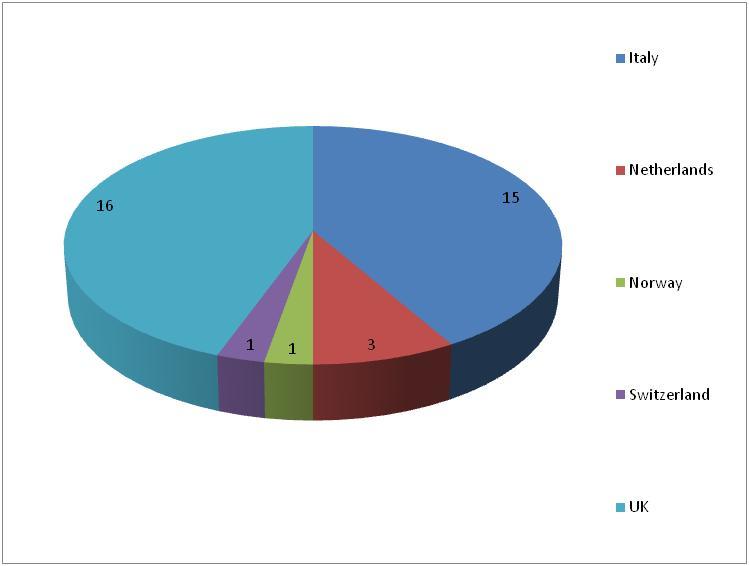
The top position in terms of location is jointly held at Sixteen percent of the top one hundred, and represented by France, the United Kingdom and the United States, which are each represented by sixteen companies each. The fourth and fifth countries in terms of representation within the data are those of Italy and Germany, making up fifteen and fourteen percent or companies respectively. Hence the top five countries, in terms of the world’s top one hundred oldest family businesses make up no less than seventy seven percent of the top one hundred.
The average age of the top one hundred oldest family businesses is calculated at 383.1 years old, of which only 32% of the companies is in fact older than that median. The oldest known family business is one thousand four hundred and 31 years old, and remains within their core business of construction to this very day. The business is currently run by the fortieth generation, with involvement of later generations currently working within the company.
In terms of analyzing these companies who have or have not undergone some sort of diversification over long histories, it reveals that 31 percent of the selection has undergone a process or strategy decision that meets with the broader definition of diversification. The figure below represents the makeup of the percentages of the companies which have undergone such strategic processes.
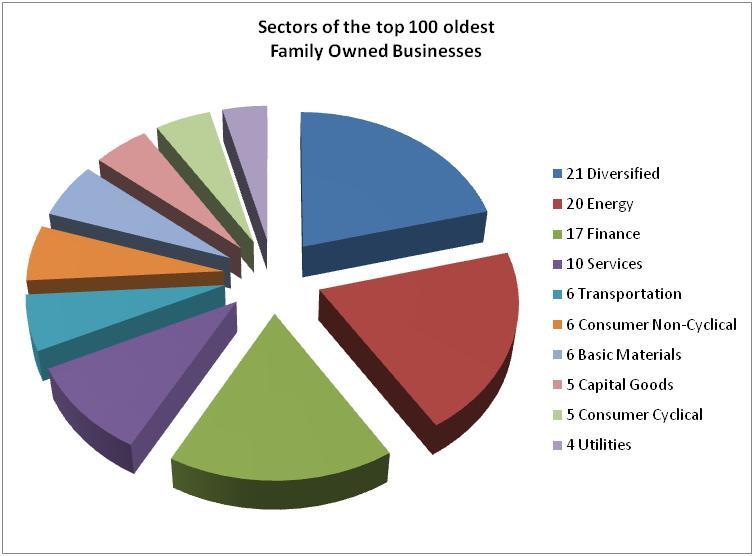
What the above figure may reveal is that a non diversification strategy may well provide the basis for longevity of the company concerned, as the proof lies literally within the figures represented above. This may be seen as those companies retaining focus have survived both issues of market and economy volatility as well as the issues of succession, which play a vital role within family business. In the case of the remaining thirty one percent that have revealed some sort of diversification, include the processes of acquisitions, mergers, product line expansion as well as complete product differentiation into different sectors completely. Although the complete diversification out of their core business area and expertise was limited to less than five percent of the entire top one hundred list, which was represented by companies leaving a specific sector and entering into a completely new sector.
In terms of the analysis of the actual diversification process, and whether the business remained within their core business activities, compared to that of mergers and geo-location and so forth the following figure represents a breakdown of the variety of diversification decisions.
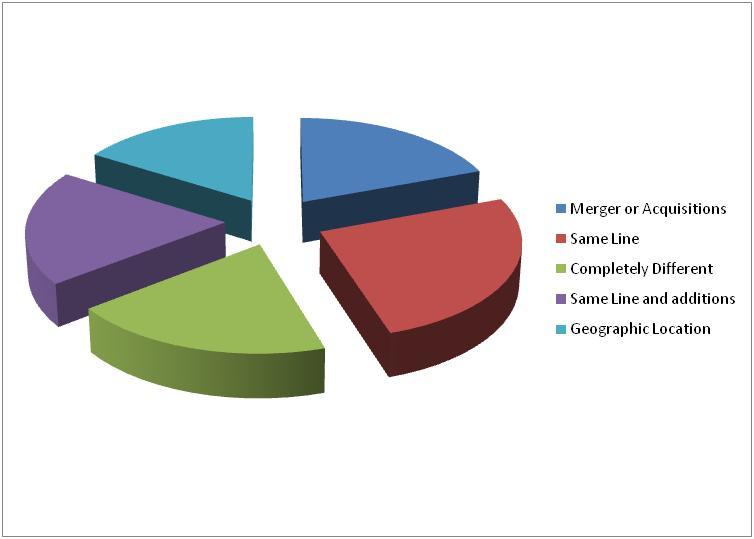
The areas into which the companies chose to diversify in terms of the above named classifications were led by that of diversifying within the same line via product expansion or service offering within the original core business activities, represented by no less than 25,81% of the analyzed 31% of top one hundred oldest family owned companies. The merger/acquisition, complete different activity and same line/with additions all shared the second top classification at 19.35% each, whilst the geographic location was the least represented process, at 16.13% or 5 companies of the thirty one diversifying companies analyzed.
Based on the fact that the companies chose to expand upon or diversify within their core business operations lead one to believe that this may well be the most popular choice within this specific data. However, as will be revealed by specific authors, this follows the academic thought of remaining within the company’s core business activity to ensure success within the diversification process. However, the fact that a large majority of the analyzed data here, shared by the second position in terms of diversification processes or options, leads one to believe that this practice in all intensive purposes negates the writings and thoughts of authors, as per a saying, “innovative efforts that take the existing business out of its own field are rarely successful” (Druker 1985, p. 160); and by considering the data above and as per the Appendices attached, the proof lies in proven ability of these top one hundred oldest family companies proving this may be challenged and is not necessarily as accurate as one might be led to believe.
Although the oldest company to have elected the strategic diversification, only did so in 1936, in which instance, they elected to merge with a competing company. At that time, the company concerned, being that of Baroviers, had attained the age of six hundred and 41 years old. The merger took place between two families, being the Barovier and the Toso families, in Italy, to create the Barovier & Taso who are the creators of magnificent glass products and decorative pieces. Though, this could be seen as diversification within the same business sector the most notable of these top one hundred companies and specifically those that have diversified might be the Italian company of Torrini Firenze which diversified from an armory or armor producer to that of a goldsmith. One of the most diverse companies that are well worth mentioning is that of John Brooke & Sons, which is now four hundred and sixty eight years old, and having started in the fabric business is now currently involved entrepreneurial development, something of a far cry from their founding activities.
The basis for analysis of these figures was to provide an insight into what one might view as the very long standing business, highlighting the diversified companies versus those that did not diversify, and whilst the majority did not elect to take this route, all of these companies are still in operation.
Considering the various academic views of diversification, such as that of Drucker (1985) who claim that broad diversification may lead to an unfocused business model that may well not ensure success to the business concerned, one has to consider the research presented here, in that respect, quite a few of the respondents diversified outside their core business interests, and yet achieved success and what appears to be sustainability based upon the average age of the business (Chandler 2003). This fact taken in conjunction with the views of Rumelt in Strategy, structure, and economic performance (Rumelt 1974), who suggested that the “broadly diversified corporation was a superior strategy to being more focused” (Thomas, Pettigrew & Whittington 2000, p. 79), who further stated that from a financial perspective.
The more closely diversified business, displayed higher profitability (Thomas, Pettigrew & Whittington 2000, p. 80). These views are essentially contradictory, yet the factual results, as presented within the study, reveal that the element of both financial performance, as well as business survival, within the sampling was achieved in both the closely and wider diversified businesses analyzed. Moores & Barrett provide that the diversification concern is in fact one of the most important strategies or part thereof within a company’s development (Moores & Barrett 2002, p. 158). And furthermore, will lead to increase participation by management, in this case mostly family members, in budgetary control and preparation (Moores & Barrett 2002, p. 100).
The larger proportion of the sampling further states that their initial decisions regarding the diversification was based on opportunities that were available within the marketplace at the time, with many taking advantage of such opportunity to contribute more towards the company and the family’s revenue streams at the time.
Academic theory inclusively related to the writings of the authors mentioned above seems to be somewhat ambiguous. Their contradictory views are held with the diversification that it should be in a more focused or closer role in relation to the businesses core activities, in which it is claimed that higher profitability will ensue the closer such diversification is. However, from a strategic perspective, as stated above, it has been suggested that a wider diversification is in fact a superior strategy (Rumelt 1974). The sampling analyzed revealed that the majority of respondents pursue the wider diversification option, with those that diversified more closely also achieved success within their respective sectors. This is proven by the fact that companies surveyed are still in existence to this day, and continue with their diversified operations and most of the businesses are being controlled by the second generation already, some of which going on to the third even fourth generation involvement level. Therefore, provided the management strategies and leadership remain intact and suitable for the relevant business. It appears that success is not only achievable but, sustainable regardless of how closely or widely the business chooses to diversify within or outside their core business sector.
Diversification Process
According to Hess, the family and the business provide for an extremely dynamic environment, when operated together, in which the business and the family overlap, and based upon the fact that each is changing in its own right due to growth, or even within the instance of this analysis within the diversification process. The family dynamics make it in fact a lot more difficult to manage a family business, as compared to a non family business (Edward 2006, pp. 25-55). The result is that many issues are integrated into the business structure than would have been in a non family business environment, which creates the challenges and potential problems that come along with the family business management and subsequent analysis thereof. Hence regardless of whether or not the family business undergoes any diversification, one is forced to consider the familial factor that comes into play in the management of the business especially during times of change.
In analyzing diversification, there are two important trends in the diversification process, according to the significant historical events (Grant 2005). These events were seen as Post-War diversification and Post-1980s refocusing. The Post-War diversification process heralded an important phase within the corporate world and can be viewed as an “important source of corporate growth” across all sectors. Within this time, a period of significant decline in single business companies was revealed, whilst the number of diversified companies in both related and unrelated sectors increased steadily in a variety of geographical locations across the world, the 1960s and 1970s considered the height of the so-called diversification boom, which naturally led on to the post 1980s refocusing trend (Palmberg 2002, pp. 129-148). Many of the diversification processes came about due to an increase in that a variety of management techniques and processes, together with the newly found “science of management” which in all encouraged businesses to take on additional business units or divisions, which is nothing less than diversification.
The issue of growth of companies, rather than that of significant profitability was another contributing factor of this diversification trend (Palepu 1981, p. 19). But in the 1980s, the realization for the necessity of profitability became prevalent and although the diversification trend of the preceding decades slowed down significantly, but practice of acquisitions continued which meets with the definition of diversification, although according to Grant, this represented an unrelated diversification (Grant 2005, pp. 447-448). Considering the average age of the respondent companies surveyed, this period coincides with many of the companies’ strategic diversification efforts, and is further confirmed by many of the various sectors within which these businesses now operate, and are truly diverse as detailed.
The refocusing efforts of the 1980s as well as the resultant affects upon performance of the company (Cantwell, Gambardella & Granstrand 2004, p. 33). Their studies indicated that manufacturing productivity increased within the United States in this time, whilst analysis within the stock market returns of companies that had diversified, had revealed a positive growth within the stock returns and market sentiment of these companies, and more specific to the sampling within this study was that “other studies also show that internally controlled firms with large-block ownership by corporate insiders show a better performance” (Cantwell, Gambardella & Granstrand 2004, pp. 28-30). This correlates with the sampling within which those companies that had chosen to go the public listed company route, whilst retaining majority ownership and control would be viewed within this sector and would show positive market sentiment as described above.
As stated, the process of diversification is often a strategic decision within which the company stands to not only reduce their exposure to a specific market, but may consider such diversification as an additional form of revenue, which was clearly indicated by the researched and surveyed companies. The choice of which route to follow and how exactly to go about such diversification is arguably as diverse as the sectors within which the companies that were surveyed operate. Hess further provides that motivating factors behind the diversification process include that of consolidation of industry, market shrinkage or shareholders, or the company itself requiring additional capital for further expansion opportunities. These expansion opportunities may take the form of a variety of different strategies from investments, to acquisitions or mergers, geographical expansion or that of product line expansion. Although diversification process should, in fact, focus upon the addition of product lines within the business current area of expertise to maximize existing infrastructure and expertise within their field of operation, this will in effect avoid any dilution of any positive traits of the organization concerned (Chandler 2003).
Primary research indicated that although a small amount of respondents remain specifically within their niches, those that did remain there in sought to add value in their immediate supply chain; the balance of respondents diversified away from their core business, and in one specific instance even ceased to operate within their initial core business area. The precious studies imply that the diversifying business, going away from the original core activities will in all likelihood not succeed compared to those remaining close to their fields of expertise (Druker 1985). To the contrary, the research has revealed the opposite of be true, where companies diversified into a variety of specialized fields and continue to function to this very day. An individual, as with a closely held family business is in a vulnerable position without seeking out a diversification strategy (Jurinski & Zwick 2002).
However, in the face of volatility, as provided by Grant, should a business elect to diversify from such volatility to escape these market conditions, they would be foolish to believe that any business operates within an ideal world situation or environment. The strategies of the company concerned should rather be seen as a guidance of what the business wishes to achieve, as well as an aide in achieving those goals and objectives, whilst providing for sufficient preparation to face adversity, volatility and risk. The only guarantee that exists is that of the calculated risk of such product or geographical analysis and market research in planning for the diversification process and activities (Grant 2005, pp. 147-148). Hence the volatility issue does not really appear to be a feasible factor in the decision making process, but rather an informed acceptance and resultant exposure to the risk thereof that has the accompanying reward of the diversification strategy and implementation thereto associated.
From the perspective of geographical diversification, the company has the opportunity of alternative geo-targeting, in terms of existing product lines, as well as new product offerings, and the election of such a strategy will, furthermore, result in growth within the company itself (Channon 1999, p. 78). Hence, by venturing away from where the company originally started operation, the company stands to realize additional growth opportunities, by virtue of the increased size of the market being sought after. This does not ever take away from the added cost in terms of logistics that will be required to deliver such product to these new geographical locations, which needs to be analyzed prior to undertaking such a strategic direction. The company may seek to establish representation in the alternative geographic areas, which in all likelihood would represent a significant capital investment, realizing the issue of whether or not to seek internal or external funding or financing for such growth.
The geographic diversification is more often than not influenced by social and political factors that further need to be taken into account prior to undergoing such strategic processes. Regions that are influenced by religion may play a role in specific products, such as that of alcoholic beverages in predominantly Muslim countries as an example and would Therefore, require the specific analysis and investigation in terms the expansion into such a market that may be adversely affected thereby. Navarro provides that beyond the business unit diversification strategy, the geographical diversification strategy may not be solely motivated by that of any hedging initiative, but rather that of achieving greater economies of scale, whilst providing opportunity to “deploy core managerial and production skills across a broader range of opportunities” (Navarro 2006, p. 11), which in essence indicates the experience sought after by company leadership in providing to and dealing with alternative markets with respect to their products and services, gaining market share as well as invaluable experience in dealing within these varied geographical areas, each influenced by their respective socio-political infrastructure.
Financing of the diversification processes may well prove to be more of a challenge for the family business, due to the fact that it is not an exposure of risk to external shareholders, or stakeholders, but rather to that of the business owners which in this instance is represented by family members themselves (Poutziouris & Smyrnios 2006). Furthermore, research by the author suggests that issues of autonomy within the business will also play a determinant role, beyond that of the acceptance of the risk associated by such a strategy and to the family members themselves. It quite appropriately to add here that “there is typically no clear demarcation line between business concerns and family concerns since the family business is typically the vehicle that fuels the family’s current income and future wealth, and business results directly affect the family (Jurinski & Zwick 2002, p. 11), which concurs with Poutziouris in that the exposure may well be greater to the family business (Poutziouris & Smyrnios 2006), and the ownership as compared to that of the corporate or publicly listed company. Although within the primary research, some of the businesses were publicly listed companies, due to be allocated shareholding the family still retained large portions of ownership, if the majority share, in which case such exposure and the potential resultant effect upon the family and the business would still be realized in this instance.
The extent to which the business diversifies would be for all intensive purposes up to the risk tolerance level of the family concerned. Within the research, one of the respondents indicated that the family had diversified into no less than twenty-seven separate companies, and into a variety of different fields and disciplines. This may be construed as an undisciplined diversification strategy, in that once a company succeeds in a specific field the owners thereof would like to “try one’s talents in new industries or geographical areas” (Gersick & Davis 1997, p. p189), specifically under that of the holding company.
Although this methodology or strategy may provide many benefits to the family concerned, specifically, in terms of the extended family such as that of cousins, as well as providing a basis for internationalization, there are disadvantages to the specific strategy, as provided by the author in “if the process is not carefully evaluated and controlled” (Gersick & Davis 1997, p. 190) which has been represented in a number of studies in which “broad diversification can distract the company from its successful enterprises and dilutes needed investment in profitable ventures” (Gersick & Davis 1997, p. 198). Once again reiterating the diluting effect of a too broad a diversification strategy. Interestingly, enough Gersick further provides that business owners are often left at odds as to how to manage or deal with the original founding business, in which many instances the family is merely attached to this company for entirely sentimental reasons. In many instances, the original business has either passed its maturity stage, or is no longer profitable or viable to retain and the most prudent course of action would be to deal with it accordingly, Although this may prove to be somewhat of an emotional challenge, based upon the involvement by the family over the years.
An important aspect of analysis of the company, instead of post-diversification strategy and performance, which can be performance analyzed based upon sectors within which the businesses had become operational or having diversified into (Cantwell, Gambardella & Granstrand 2004). Although the interpretation of relationships between diversification and performance seem to be somewhat controversial, due to conflicting evidence, as well as diversification processes and timing which would naturally skew the results (Santalo & Becerra 2006). As revealed in the research a number of respondents took advantage of market opportunities, and Therefore, entering the market with the right time enabling a significant growth phase which was uninhibited by any major barriers to entry, that essentially did not exist at that time are prevalent today. This is confirmed by the ‘mixed response’ of the positive or negative nature of the diversification decision and process as revealed by the primary research data.
Additional factors of diversification, which may or may not be conscious decisions in terms of such a strategy include that of the technological diversification within a company, in the process within which the variety of sectors update their existing infrastructure in order to realize the benefits of improved technology and processes, regardless of the sector within which they operate. Within this process of modernization a large degree of training, as well as significant capital investment is more than often required in order to meet the investment requirements. This may not be considered as a strategic diversification, with in the initial phases thereof however, considering the overall impact upon the organization both from a capital intensive as well as productivity perspective such changes can very well be regarded as diversifying.
The controls of the diversification process is best described by Porter in terms of the competitive advantage analysis of the business, as provided in Porter’s “Better Off Test”, and specifically pertaining to that of business unit diversification (Grant 2005, p. 254), although this can be applied in essence to a geographical strategy too. In essence the better off analysis provides that the business stands to gain from such a strategy and is in a better off position, both financially and operationally than prior to undertaking any strategic decisions or movements within the desired direction, as identified by any market analysis or research. The consideration of suitability of pursuing any such move will be affected by the financial resources immediately available to the family business or family members involved within the company, alternatively the associated risk of seeking external funding will become apparent, with the potentiality of loss of autonomy becoming a determining factor.
In the event of survival of the business, as represented by the respondents the family members may be faced with the opportunistic options of increasing revenue streams, which is represented by the diversification of the business interests in terms of the fields and markets within which they operate, or the alternative of a quickly diminishing market, for whatever reason realizing the demise of the family business concern. The latter represented by one of the respondents within the study, in that failing the process of diversification, the company would no longer be viable or even in operation. In as far as the research panel goes, there were no specific mentions made of acquisitions or mergers in terms of the respondents and hence the optimization of any merged or acquired units does not come into play here but rather the efficiency within which the business unit diversification has taken place or been taken advantage of.
Facilitation of the diversification process can take place by means of a variety of financial means by which the family members will decide the loss of autonomy, in the case of a publicly listed company in which majority shares are not retained, or alternatively by means of internal funding by private fundraising. The private fundraising exercise will entail additional exposure of personal finance standings to financial institutions in the form of private loans or investments from personal sources, or the acquisition of financing based upon the financial standing of the family members themselves. This will increase the risk exposure to the personal members of the family at an opportunity cost of the consideration of the loss of autonomy, and hence careful thought and strategic planning is required in either of the routes under consideration in terms of the financing possibilities of such a strategic determination. Thereby the reduction of risk from a business exposure and operation perspective is transferred to the individual members of the family in the case of private financing, whilst the public listing of the company would in all likelihood result in sufficient capital for development, reduction of risk to personal family members but the loss in complete autonomy of control of the business.
Beyond the perspectives described above Navarro provides that the business leadership unit seek diversification, whether it be from a family business or publicly owned perspective, for the purposes of hedging against business cycle risks and associated elements, where outsourcing and ‘off shoring’ are factored into the business unit and geographical diversification possibilities or options, quite aptly quoted by Navarro in Jurgen Strube’s statement of “the challenge is not to avoid business cycles but to manage in such a way that [the business units] will perform, on average, well” (Navarro 2006, p. 151); which is in essence is what many businesses strive to achieve, this is represented by the fact that a business remains within operation by profiting from the business environment, despite the associated loss that may come along with the markets and business cycles, provided the business is profiting it remains a viable opportunity for the owners thereof.
Scott provides further insight in his analysis of diversified firms versus those companies that did not diversify, on a so-called purposive basis, as well as the resultant behavior of the relevant companies (Scott 1993). In terms of purposive the author provides that the companies took advantage of opportunities within their core areas of expertise and the major differences revealed from the study revealed that the purposively diversified company conducted more research and development than that of the non diversified companies. This would result in an additional expenditure cost for the company, and whilst this research is consistently undertaken the diversified company would in all likelihood continue with such strategy based upon their research efforts (Malerba, Lissoni & Breschi 2002, pp. 69-87). This represents the issue that once the primary diversifying strategy is undertaken, this will lead to further diverse markets and product offerings (Scott 1993, p. 125).
This research is confirmed by the primary data within this study, specifically with the proportion of respondents that indicated additional opportunities that were undertaken by the companies, resulting widely diverse structures, mostly managed from a central holding company or the family unit itself. With a small percentage of the researched companies widely diversifying, the majority of respondents seemed to stay within their respective markets, in the broader sense of the sector concerned. To a large degree, this does confirm Scott’s research, in that once the initial diversification strategy has been undertaken the company continues to seek out opportunities, albeit by research and development or whichever means necessary in order to realize whether or not any competitive advantage can be established for the company, and whether such opportunity will represent growth potential for the company concerned. It appears that the risk associated with such strategic decisions is lessened, in the eyes of the diversifying business or family members, once the initial step has been taken in such a strategic decision.
In terms of further analysis on the research and development perspective, as provided by Scott, Villalonga & Amit provide the following “family and nonfamily firms also differ significantly in their investment policies. Family firms have relatively higher capital expenditures but slightly lower R&D expenditures (Yang 2010). They are also less prone to being diversified than are their nonfamily counterparts. Consistent with their diversification profile, family firms’ stock returns show higher levels of risk, both systematic and idiosyncratic. This pattern contrasts with the conventional wisdom that families may be inclined to diversify their firms to make up for their lack of personal diversification” (Villalonga & Amit 2004). This is somewhat contradictory to what Scott provides. However, this is not the only area of contradiction that has been revealed by the study and research within the family business and related diversification issues. The authors here provide that valuation studies by two separate groups, in terms of Tobin’s q was higher for family firms than non family firms in one study and in a separate study by different academics the opposite was found to be true. This arises as to which of the information or data is the more reliable and more importantly which is the more relevant or which should be taken as more accurate.
The consideration of company legal structure appears to be confirmed, within our study, with that of Phan & Butler who provide “alternative mechanisms of control over the governance of the firm often utilized to retain influence of critical strategic decisions and guide the firm during times of crisis” (Phan & Butler 2008, p. 7); in that regardless of whether the company with the sampling took on the legal structure of limited liability company or public company, it was done in such a way that control was in fact retained by the family via a mechanism of majority shareholding retention by the family within either form or structure of the companies, as mentioned. The authors furthermore confirm, together with the findings of the surveyed companies that the original family ethic is retained within the business, in terms of leadership and management of the company in “a strong culture of regard for the preference of the founder or founding family may be enough to influence the decision making process of hired managers and independent directors” (Phan & Butler 2008, p. 7). However, according to Moores & Barrett, the structure of the family firms affect both “the content and the form of controls” of the organization itself, inevitably when any structural change occurs, so well all the controls albeit from an operational, or profitability perspective, with many of the responsibilities vesting with management (Moores & Barrett 2002, p. 136).
Bearing in mind that family businesses account for between 80 and 90% of all businesses in the United States and 75% of businesses in the United Kingdom, as well as 80% of businesses in the Philippines (Johnston n.d.), to name but a few of the available geographical statistics; the realization, not only of the contribution of these businesses, but to the extent to which these businesses occur one has to consider the fact that such control as mentioned above is prevalent across these quoted statistics. This implies that such family values and ethics are carried through to these businesses which account for such a large percentage of economies across the world.
Tying in with that of Phan & Butler’s views, is that regardless of company legal structure or formation these companies are under the control of the founder or founding family and operate accordingly their terms of strategy and critical business decisions. In terms of analyzing the family business, one should also not consider the business to be that of a small operation, that may be working from home or a small office or warehouse somewhere, as provided by Johnson (2004) “37% of Fortune 500 companies or family owned while 60% of publicly listed companies are family controlled” (Gersick & Davis 1997). Study provides that on an international basis between 65 and 80% of all worldwide business enterprises are owned or managed by families (Gersick & Davis 1997, p. 2). Such control would arguably be in the form of majority shareholding, by the family concerned that has been confirmed within the sampling.
The above serves to confirm that regardless of company structure, within the sampling, control over the various diversified business units was ultimately retained by the family in concern.
The various motivational issues behind that of the diversification of family business, is confirmed by the sampling’s response of increasing business strength, which leads directly or indirectly to increase profitability, which ultimately provides a greater revenue stream to the business and family ownership unit. The academic measure of the diversification process while that of Michael Porter’s “essential tests” was not specifically and directly addressed with the sampling (Granados 2004, p. 8). However, two of Porter’s tests were revealed in the responses by the sampling, being that of the attractiveness test as well as the cost of entry test.
A large proportion of the sampling indicates that opportunities within the economic market presented themselves, which is a direct indication of the attractiveness test, as the management and ownership of the business that time realized inherent value in taking up such an opportunity at the time of diversification. One of the respondents specifically mentioned that entry into one of their diversified markets, would not be possible to date due to the cost of entry, and on a retrospective basis such diversification had not capitalized on the cost of entry into their chosen diversified field, and would therefore, be justified in terms of such strategic decision at the time. Grant (2005) specifically stated the company being “better off” based upon profit generation, either via mergers or acquisitions, this issue did not affect the sampling in this case, as no specific mention has been made of an acquisition or merger drive from any of the companies within the sampling. However, such diversification and strategic decisions were based upon a more generic and internal process than that described by Grant, Therefore, such theory not being applicable to the sampling surveyed.
The issue of resources of the family business from a financial perspective was not directly addressed by the respondents. However, from the provision of responses with respect to the company structure, one might assume that such financial resources were generated from internal sources or via traditional funding sources such as that of financing houses, or banks. This is with the exception of the publicly listed respondents, represented by just over 22.72% of the sampling, in that they had elected the public company route. In all likelihood the publicly traded company is a mechanism to generate sufficient financing to fund such expansion activities, and once again the control was retained via majority shareholding of the now publicly traded company, coinciding with that of the statistics as quoted by Johnson (2004) above.
The balance of the companies, within the sampling did not specifically claim internal funding or loans via banks or similar institutions. However, the inference of a limited liability company, being that of a privately owned company, is that of self or internal funding, in essence not wanting to open the company up to too much external influence. However, whilst protecting the interests of the family members via such a legal company structure, from a liability perspective. Rising of external capital may well be more expensive, as provided by Grant (2005). However, once again based on the fact that these businesses are still in operation, regardless of the means of how and where such financing was obtained, attests to the fact that the necessary funding was indeed obtained and allocated efficiently to ensure the apparent success presented within the study. For those respondents who elected the public company route, one may surmise that the capital requirements were too vast for self funding and therefore, the need for such listing was made in order to meet capital requirements within the diversification drive.
An alternative form of growth, being that of mergers and acquisitions was not highlighted in the primary data, which in fact coincides with Davies (2006) who provides that family firms preferred the organic growth aspect, based upon the fact that most families work within a family controlled businesses as a form of working on the inheritance factors, by implementing a merger or acquisition strategy the inherent risk is represented by the addition of an unwanted culture being brought into the business. Therefore, the issue of diversification or other alternative organic growth seems to be much preferable to the family owned and or controlled enterprise. This change in culture is neither desired by entrepreneurs nor family businesses (Ravensburg 2009, p. 13). Furthermore, based on the fact that the entire sampling seems to represent an entrepreneurial spirit, in addition to the fact that these are family owned businesses, such change in culture is ultimately undesirable (Davies 2006, p. 98).
Human resources requirements become important once the company begins to grow, and in the case of diversification, a number of elements have to be decided upon by the controlling family, who may well retain control will have to start delegating and so called letting go of certain functional activities within the business (Rowley & Abdul-Rahman 2007). Naturally the need for an increased workforce is presented upon such growth, and along with such an increase within the human resource element is the requirement of efficient and effective management according to the strategic goals of the company concerned. The sampling provided a number of possible solutions or elected procedures, which included the outsourcing of the human resource management function, as well as the establishment of specific specialized companies for each business unit, whilst retaining an oversight via the holding company, which in turn held the control in the various individual companies.
Beyond the management of human resources within the now diversified firm, as well as an aspect that touches upon the structure of the firm, business risk becomes inherent in the business environment, where something might go wrong within the delivery of a product or service to the end user or customer, in which instance the customer may sue the company (Sadgrove 2005). This insight provides for the formation of the limited liability company and the public company, which provides some protection for the shareholders. However, this is not the be all and end all of risk management, which filters through to the human resource element, as well as the issue of business continuity, in the event of legal action being brought against the company due to the action or inaction of employees, management or leadership of the company.
The human resource element of the family business is further extended to include the fact that the family dynamic as well as the corporate structure becomes intertwined within the corporation itself, with this being coupled with the concept of succession, a number of possibly difficult business decisions and issues may arise from this closely bound relationship (Raghavan et al. 2005, pp. 4235 – 4265).
Succession planning, as provided by Gersick (1997), is often blamed and labeled as such in the event of family conflict within the business unit, it is furthermore a field of expertise that is more often sought than not to be dealt with on an external or consultancy based basis. Gersick (1997) and Poutziouris (2006) further provide that extensive literature exists on the succession planning and implementation phases, with two opposing forces becoming prevalent during both the planning and implementation phases. These forces include from the senior level, in not wanting to let go and from the junior level of not wanting to wait for the succession implementation. Gersick further provides that the distinction between succession and continuity must be drawn, with the senior generation more often than not becoming concerned with the issue of continuity rather than that of succession, with an amount of confusion being represented in this ‘senior opposing force’.
Specifically pertaining to the issue of succession, within our sampling it appears that all of the respondents involved seem to have dealt with the primary steps of succession with the involvement of the second, and in some instances the third generation. The median of generations within the sampling was slightly over the second-generation, represented by an average population of 1.6 generations that were involved in the family business. Therefore, one will notice that these primary steps have been taken, due to the involvement of additional generations, with the remaining issue of the senior generation having to “let go” when the time arises. However, due to the fact that the majority of the businesses within the sampling are relatively young, represented by a median of 15 to 17 years lifespan, one would expect that such specific “letting go” phase is yet to come. This is further confirmed by the sampling’s acknowledgement of the fact that numerous generations are currently still actively involved within the leadership structures of the relevant businesses.
Relevant research into family ownership of a business that has undergone the diversification process and publicly listed as a result, Villalonga & Amit (2006) have found via relevant data collected that the value of the company is enhanced in the event of the founding family member serving as the prime leader of the company, such as the Chairman or the Chief Executive Officer. In the event of descendants taking up such a position the value of the firm is reduced. This issue further raises the importance of the succession management and planning in order to retain the value of the firm, as well as retain investor confidence where applicable, as the founding member cannot serve the company in perpetuity and will have to at some point relinquish control of the company in question.
Another pertinent issue is that of the diversification of investments by the family business. Investments may refer to the reserve capital in the company, which may form the basis of income for the ownership or family in the case of volatile economic conditions or market slumps. According to Schmid, Ampenberger, Kaserer & Achleitner the research based upon family and non family business pertaining to the use of cash hedging instruments as a form of diversification revealed that the family owned business was less likely to use the cash hedging option than that of a non family business which provides that the company from a non family held basis may well be less risk conscious or possess a higher threshold for risk taking initiative than that of the family held or owned business (Schmid, Kaserer & Ann-Kristin 2008).
Methodology
Methodology of this study involves two phases. First phase is the literature review that has already been discussed above. Literature review involves taking help to bring all pros and cons of your topic in to light. It involves referring to the researches of others so that to assess and evaluate the findings of other papers (Kerr 2000, pp. 6-10). Literature review is the backbone of any dissertation as it discloses the clear picture of one’s topic. Researcher summarizes the points and then move on to the next stage, i.e. the real or practical side of any study. Therefore, the second phase of the methodology involves research. As discussed above, literature review involves secondary data that are also called the processed data. While the unprocessed data that a researcher collects himself using various methods while researching, is called the primary data.
Collection of Primary Data
Prior to the collection of data and submission of the question, specific definitions to which the surveyed sampling should adhere are provided below, as well as a description of the questionnaire design and submission process.
Definition of Terms
The following definitions are relevant to the subject being researched here, and for the purpose of clarity and understanding specific definitions must be accepted for the research and analysis of the diversification effect upon family businesses. The Family business is defined in a number of ways. However, there seems to be an overriding central theme, which is represented in the following definition, which will be accepted for the purpose of this study: “a business actively owned or managed by a member of a family, in which other family members may or may not actively participate in the management thereof. However, the majority ownership rests within the mentioned family.” This provides the starting point of analyzing how a family owned business is affected by the decision and process of diversification, duly defined below.
The definition of diversification that needs to be accepted here is based upon the fact that it is the very decision or process that is central to understanding what the changes are and which that are effected, how these changes affect the company, the stakeholders, as well as the strategic position and future of the company concerned. Therefore, for the purpose of this analysis the definition of diversification that will be accepted is as follows: “diversification is the decision, and resultant process, of risk reduction which can involve the addition of products, services, clients as well as markets and locations to the company undergoing or intending to undergo such diversification. This process can be motivated via both seasonal and economic fluctuations within the company’s sector, and may further be a strategic invasion into a specific and defined market.” This definition may also extend to the investment of surplus funds that may be available to the company as a form of income generation or security, generated in the times of substantial excess gains or profits made by the company.
The analysis of the family owned business that intends to be undergoing or has undergone the diversification decision and process will be conducted via a primary and secondary research objective. Within this research a questionnaire has been designed and dispatched to numerous family owned companies, randomly selected and both geographically and sector differentiated, referring to their physical location and their primary or core business activity respectively. In order to obtain as wide a research result as possible, thirty questionnaires were forwarded to family owned businesses. The results and analysis are thereby provided within the following sections of this paper, together with the discussion of the questions contained within the questionnaire.
A number of issues regarding the results that have been highlighted from the research will be discussed with reference to theoretical or academic literature as well as to commercial or “real life” examples; this will be conducted due to the fact that within the so-called real world events, they do not necessarily occur in the way in which one may wish events to occur, or according to the ideal world scenarios that are often referred to within academic literature. Therefore, the analysis and findings will be able to provide an insight into the actual process, as well as highlight potential advantages, disadvantages and problems that companies may incur along the diversification journey.
The conclusion will be supported by the analysis of the research and will aim to identify possible routes or elements of success that are provided by the research, as well as possibly form a frame of reference for future companies, in which they may realize the true effects of diversification from both a negative and positive impact upon the family business.
Research – Questionnaire design
The questionnaire forwarded to the family business, which forms the basis for the primary research methodology, consists of total 25 questions; the entire questionnaire is attached to Annexure A.
The questionnaire was designed using a web based tool Survey Monkey and was sent on an anonymous basis, to a geographical diverse audience, to gauge whether the geographical location does or does not affect the family business in such a process, and if so to what extent such geographical positioning is relevant. This may be specific to country laws or practices, as well as any possible significant cultural influences that may well be relevant to the business itself.
In order to establish the relevancy to the business being interviewed, the question is set to ascertain whether or not the respondent considered their business as being a family business. This is important in establishing the relevancy of the questionnaire to the business being interviewed, with another question confirming the level of ownership and / or control within a specific family or not. These questions serve to qualify the respondent businesses in accordance with the accepted definition, as highlighted above. The question pertains to the length of operation of the business, which is required to establish to what effect and extent the change was, which further serves to highlight the positive results of diversification in assuming that such a process or decision was in fact directly responsible for the company still being in operation to this day. The preceding question is supported by the question in establishing which generation is now running the family business, Therefore, supporting the length of operation of the company.
The core business or activities of the business in question serves to highlight or confirm the necessity of the diversification in terms of the current economy, or the state of the economy as it was in the instance of the decision or process being undertaken or initiated. This serves to establish how macro or micro economic factors are relevant to the business regardless of size or structure, with the question pertaining to the structure of the company serving to establish any unique issues or consistency in type of business structure relevant to the family business. This in line with the ‘international’ distribution of the questionnaire is to provide an underlying commonality of the formation and structure of the family business or the lack thereof.
Additional business interests on the part of the family in question may also be indicative of the diversification of the business, which may have come about to the need to extend or expand the business interest, in which instance the reduction of risk may have been deemed to be more effective on the establishment of an additional business, instead of changing the existing business or structure as well as the core competencies. This may be reflected in the alternative or additional business being wholly owned by the business in question, in which instance such a business entity could well be envisaged as a diversification effort on the part of the business. The 8th question serves as confirmation of the preceding statement, and determines the level of such diversification interest.
The primary motivation for the diversification process and the decision will provide an insight as to whether or not the company’s survival depends upon the process of diversification, or whether the company is seeking the mentioned invasion into profitable markets. Whether or not the company ownership made the diversification move due to market or product maturity will be reflected in the response of this question, which adds to the analysis of motivation of the process and decision. The following question extends further to analyze the market position of the company immediately prior to the extension of the company, in the form of their diversification process.
The next question seeks to establish whether or not the diversification process ceased after the initial process itself, or whether or not the company continued to evolve in line with its initial realization of diversification, which serves to prove whether or not the initial process served as a catalyst for the continued expansion of the company.
Organizational structure is analyzed from the perspective of whether or not the company would have had to take on additional financing or partners, which is represented in the twelfth question. Answers to this question will provide whether the majority of respondents in our sampling needed to facilitate structural change or not, as well as highlighting the need for external financing to enhance the process or even enable the company to conduct such changes as were necessary at the time of diversification. An important factor on both the structure and control of the company has been claimed by many authors, the questions pertaining to this is to establish whether or not such changes have occurred within respondent companies and to which extent. Responses within this area further motivate the concept of how drastically the decision impacted upon the company and to what extent these changes have impacted within the physical control and management of the company.
Many family owned businesses are often seen as more flexible due to the fact that any organizational changes or decisions pertaining thereto can be decided upon more quickly and with less so-called red tape or bureaucratic processes than that of the listed company. Hence, any changes within the business after the diversification will be reflected in the ability or inability of the company maintaining such flexibility or autonomy within the company during the decision making processes.
Ascertaining the impact of corporate governance is deemed to establish whether or not this issue was in fact considered at the time of diversification, and seeks to establish whether or not the management or ownership of the company has considered the impact thereof on the now diversified business. The distinction between whether or not such governance is a prerequisite or actually an asset to the business serves to establish the positive impact or benefits arising from the necessity of corporate governance, or whether the practice thereof is deemed to adversely affect the company. In many instances the corporate governance issue will be a new policy or practice for the family business, which would now in the post diversification phase have to implement this practice and these stipulated regulations.
The view of overall negative or positive impact of the process must be established in order to retrospectively measure the success of such processes and decisions, in order to establish potential future strategic moves for the company, or within other family businesses. It may serve as a frame of reference for future business decisions in difficult markets or even those markets that are seen as saturated. The question regarding the core business perspective thereof may also serve to establish whether or not the company still maintains such core business, or perhaps if the decision to diversify may have led the business into a different product or service offering that leads them away completely or even partially from their original core business practice.
Quantitative vs. Qualitative within the research process
The process that has been undertaken in establishing a sampling within the family business ‘sector’ is based upon that of a quantitative approach in obtaining the insight as well as to the effects and what has led up to the mentioned process of diversification. Whilst one may determine that the actual diversification process, which is highlighted within the research forms part of a qualitative subject or process, as these decisions may or may not be guided by market forces with respect to diversifying.
The methodology of the surveys sent to the respondents can be classified as an online methodology, as the questionnaire was forwarded to the respondents via email, as per the format in Appendix A.
A total of thirty questionnaires were forwarded to known family businesses via colleagues, friends and family. The questionnaires contained the questions discussed above, and form the basis of analysis of how diversification affected the family owned businesses, and to what extent this process and decision affected the concern, as well as what has essentially become of the business on a post diversification basis. Further insight into the family business with respect to which trade sector the business belongs to, as well as issues such as age and generations involved within the business that serves to establish whether or not any sort of trends exist in regard to this process and decision.
Of the submitted questionnaires only twenty two questionnaires were returned, which represents a 73.33% response ratio, the balance of questionnaires and the reasons for non completion were stated as the people who were approached were too busy with their daily management activities and obligations to complete the requested information. In addition to this, four respondents stated that they were not prepared to provide answers due to concerns of confidentiality issues, despite the assurance that none of the information would be published and was for analytical purposes only. The sentiment as previously described is confirmed by Poutziouris who provides that “given the private nature of most family businesses, accurate information about them is not readily available” (2006 p. 56), which provides some sort of confirmation as to the expressed wish to not participate within the presented study.
Yu & Cooper (1983) provide that although numerous research exercises have been undertaken to improve response rates in an attempt to reduce non-response bias. However, although these approaches have been suggested “little is known about their relative effectiveness” (Yu & Cooper 1983). Hence, based upon the reasons for non-response of the mentioned selected sampling, it is a suitable justification that the responses received are in fact sufficient for the analysis herein contained.
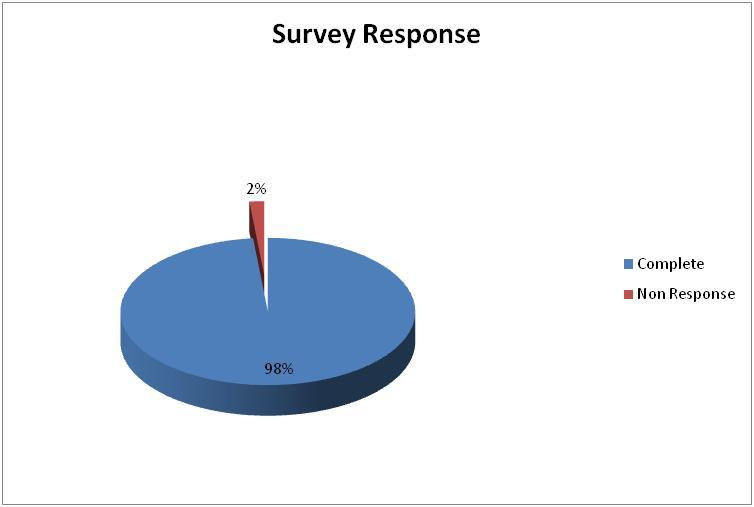
The 98% response rate is higher than the “market standard” of 50% and above, considering the nature and “niche” of this specific analysis, the representative sample is deemed to be sufficient, due to the variety of responses, sectors and structures as per the completed questionnaires that have been received. The sampling represents businesses that are deemed to satisfy the family business definition, as per the outlined definition of terms, as well as having undergone a diversification decision and resultant process, with the exception of one respondent. Therefore, for the purposes of this analysis the sampling is considered 98% within the family business definition and the respondents or the sampling have undergone some sort of diversification within their respective business life cycle.
Findings
Findings of this study are based on two phases, the literature review and the research part.
Analysis of Literature Review
The following discussion is based on analysis of academic, as well as statistical information specifically pertaining to the family businesses and their involvement within society and the economy in general, in order to get an understanding of how the family businesses impacted upon, via mentioned issues such as diversification, corporate governance and so forth.
Cater (2006) specifically provides that the duality of the success of a family business is dictated by both family life and business life, which is compounded by the family business unit, which in turn adds a degree of complexity, to the already complex nature of business with the possibility of family relationships affecting the work environment. Cater further provides that one of the leading topics in research and family businesses is that of succession, which may be confirmed by the degree of involvement by the number of generations as highlighted in the sampling collected. One of the key points highlighted by Cater is in fact that 70% of family businesses actually fail to successfully implement a succession of policy from the first to the second generation, representing a massive loss to the economy.
Considering the family business has survived the diversification process, but stands to fail in the succession process would truly represent such a loss, after many years of survival both pre-and post-diversification. In addition to the recent statistics provided, of the 70% of the failure rate, should the business reach the succession stage from second to third generation only 12% of these businesses successfully implement such a change over with succession from third generation to fourth possessing a mere 3% success rate. Cater’s research further coincides with that of the primary doctor represented here, in that the average lifespan of the family business is quoted as 25 years, less than the median of 33.41 years as represented in the research. This may indicate that the various businesses surveyed in the sampling may well not be around within the next few years, unless a concerted effort and well-managed succession plan is put into place.
Based upon the mentioned statistics, of 60 to 85% of all businesses on an international level being under family ownership or control the issue of succession suddenly appears to be of vital importance within this form of ownership and control. Regardless of successful leadership and strategic decisions a family that controls its business units should be in a position to implement a viable and sustainable succession within their ranks, all efforts within their business sectors regardless of whether diversification strategies were undertaken or not, it would in fact all be a waste of time.
Moores & Barrett (2002) not only confirm the issue of succession, as described by Cater, but further delve into the growth dynamic of the family business, which in essence is associated with that of diversification as it is described throughout the study. Such internal issues are further exasperated by that of external pressure, such as changing technology, government incentives (or the lack thereof), customer preferences and opinion which are then carried over to the structure of the firm; in that questions of workload management, structure and ownership begin arising placing added pressure on both the business and family unit respectively. Moores & Barrett claim this to be the context of the business, and further state that the company “whether family owned or not – needs to engineer its internal situation to best fit its external environment” (2002 p.13); these issues effectively referred to as contingency plans have been greatly researched by what the academic world refers to as organizational theorists.
Managing all through the internal situation, as well as the external environment and any business decisions pertaining to these elements are according to what the authors referred to as strategies, which in this study refers directly to the process and decision of diversification, the allocation of resources and the resultant business units and companies created from these processes. Kuratko & Hodgetts also make mention of what they term as, “Forcing Events” which can be likened to that of death, illness, abrupt departure, legal problems, business decline and financial difficulties. The authors furthermore claim that the family business, and the family itself “seldom has a contingency plan in dealing with” the aforementioned forcing events; these issues further exasperate the issue of succession, as well as the future efficacy of the leaders of the business (Kuratko 2008, p. 491). One will Therefore, realize that besides the “normal” succession of procedure within the family business, these contingency plans need to be incorporated in the event of the mentioned forcing events occurring, whilst furthermore implementing suitable succession programs or policies to ensure the continuity of the growing concern.
Coinciding with the some of the wider diversification examples contained sampling Moores & Barrett confirm that “these family firms operate in a greater number of markets and have to take account of more areas of development.” (Moores & Barrett 2002, p. 134). This may well represent an agreement with respondents from the survey, who stated that upon undergoing the diversification process focus was taken away from the original core business because of the need for attention on their respective ventures and opportunities that were taken at the time. The authors further provide that the strategy of diversification “represent distractions from their core business” which does in fact coincide with representative sampling within the data analysis.
In contrast to the issues of succession as already described Weidenbaum provides a perspective on the Chinese Family Business, which may well be represented by more of a private ownership than that of a publicly traded company, although this coincides with the sampling majority within the study; from a succession basis the author provides that “succession typically runs through the family group, rather than depending upon seniority.” (Weidenbaum 1996).
Further expanding upon the difference between the family business and the non-family business, Kuratko & Hodgetts (2008) provide that the overlap between family and business will vary between each family business concerned. However, this was not entirely revealed within the sampling, but rather the strengths of individual family members were deployed into specific areas where upon the content family member displayed sufficient skills in terms of the management and leadership of the sector concerned, no real evidence was provided that family issues were brought into the business and rather a more holistic process of leadership within the family seems to have been displayed by the sampling.
With further relevance to the succession issue, a number of strategies exist, as highlighted by Kuratko & Hodgetts and specifically that of early entry strategy and delayed entry strategy, with each strategy having their respective advantages and disadvantages. The fact that a secondary or tertiary generation has become involved in the business does not necessarily indicate that the business has proceeded successfully with a succession program, and has provided by the authors one of the main issues that the successor will have to address is that of gaining credibility amongst employees of the firm, and their ability or inability to do so. In addition to this the authors provide that the founding generation normally prefer a succeeding generation, or the succeeding leadership to actually work outside the firm where there may learn, and make mistakes prior to taking over the leadership of the company concerned. These issues were not confirmed by primary data, based upon current statistics of the family businesses that succumb to failure within the succession process, it is well worth noting, specifically with respect to the mentioned early and late entry strategies.
Although these strategies may have specific advantages or disadvantages respectively, it would really depend upon the family concerned as to the encouragement of the involvement of the succeeding generation. Some of the advantages of the early entry strategy include a more intimate relationship with the business and employees, specific skills pertaining to the relevant business are developed, achievement of credibility ensues; on the other hand the advantages pertaining to delay entry include a more objectively judged scenario of the successor by the employees, success of self-confidence and achievement development, overall business perspective is widened by the successor. The disadvantages for these respective strategies include from an early entry perspective, being that of the aforementioned opposing force of relinquishing control to the successor, mistakes viewed as incompetence, and limited overall business knowledge and experience. The delayed entry strategy disadvantages are described as key business strategies, and success factors specific to the family business may be lacking, outside business “habits, or patterns” may conflict with that of the family systems, including values and ethics, resentment amongst employees may occur with implementation of the successor from within the family, instead of that of a long serving employee (Kuratko 2008, p. 492). Based upon the primary data analysis, supported by the involvement of multiple generations and in addition to the lifespan media and identified within the analysis, the majority of successful involvement within the business in all likelihood appears to be that of the early stage entry strategy, in which entire generations have been involved and continue to be involved in the family businesses as described.
Based on the issues described previously mentioned authors one might expect that a possible problem in the succession will be in all likelihood caused by the two mentioned opposing forces, based on the fact that it appears the succeeding generation has been deployed within the business on an early entry strategy basis, whilst these opposing forces of letting go by the senior generation, and impatience or waiting there for by the younger generation may be the two, or either of, factors that may contribute to the failure of the succession process when the time comes about. As previously stated with successful succession it may well occur that these very businesses surveyed within the primary data, may no longer be in existence in the next few years, based upon the previously mentioned issues as well as the median average age is revealed in the primary data analysis.
Beyond issues already discussed, and a further point of interest that is well worth mentioning and discussing is that of corporate governance and the impact thereof upon the diversified family businesses in particular. In regard to the specific primary data research it did not seem that corporate governance carried much weight amongst the respondents, and seemed to be an issue that was meant to be adhered to, and not a vital tool that it could well be used for. Davies (2006) defines corporate governance as a system by which companies are directed and controlled, with directors being responsible for such governance, which in turn raises the issue of accountability in terms of the leadership of the company concerned (Davies 2006, p. 3). In addition to this definition Morck (2005) provides that a number of authors claim the issue of governance emanated from that of bankers to ensure repayment of financing by companies (Morck 2005, p. 52).
Morck further provides that different countries have different sets of rules and regulations in terms of the corporate governance practice. However, within the study it should be highlighted that the issue of governance is more focused upon the management, control and leadership of the company for the purpose of continuity and sustainability of the family business concerned, and how management and ownership relate to each other, which is in line with previously discussed issues of succession and so forth. The issue of corporate governance does not come without related problems, as Morck provides that with the different structures in place issues become relevant in terms of allocation of control, funds and so forth; but as stated a more transparent and sustainable “rule structure” should be implemented within the family business environment, beyond that of any legal requirement adherence, to ensure the survival of the business, for the benefit of the family and the economy as a whole.
Aronoff & Ward provide that the organization of the company’s board of directors, in the family business is often underestimated by the controlling family themselves, with respect to the potential contribution that such board members can bring about. In addition to this, authors provide that some might criticize the privately held company, and family control as a convenient way to channel director fees to family members, which may well be the case as represented by the primary data in which it was revealed that board members are in fact family members (Ward & Aronoff 1996, p. 30); alternatively the authors state that examples exist with family members which have openly agreed that the appointment of outside board members, meaning those that have no ties with the family besides that of the directorship of the family controlled business, has in fact provided significant improvements to the business, specifically for those business owners that are truly interested in the perpetuity of the business concerned. This contributes to the many mentioned succession and continuity issues, thereby revealing how corporate governance is interrelated with one of the primary potential failure issues of the family business, being that of succession is described.
Beyond the issue of good governance aiding in the succession and continuity of the business, in terms of present-day operations Aranoff & Ward confirmed that all their governance is somewhat of an abstract concept, this concept can go a long way in assisting the family unit in terms of “smooth decision making, cohesiveness, effective conflict resolution and freedom from political warfare” which all aide in the development of a “healthy and sustainable” family business (Ward & Aronoff 1996, p. 53); with two distinctive approaches pointing to the governance of the family and to that of the business on two different levels. This is confirmed by Davies (2006) who provides that the “importance of proper governance within the family, and separately for the business, is emerging strongly” (Davies 2006, p. 95); this does not appear to be the case within the primary data, as the vast majority of respondents hardly commented on the need of such governance, as well as only a couple believing that such governance was a tool for optimization, as described above.
The governance issue will also spill over into the interests of non family stakeholders that are within the business, being that of employees. Herewith the issues of discrimination are raised, as the astigmatism attached to the family is that the employee may never specifically progress within the company, due to such non family involvement. On the other hand, the level of ethics, the culture and the environment created by the family may well perhaps counter any such perceptions, but the governance is sure to establish a set of rules that can make the employee more comfortable in terms of not being discriminated against. One of the respondents within the primary data, specifically stated that the employment and human resource function was attended by an external consultant, which coincides with the view of Davies (2006), in which “it is becoming accepted practice for appointments to be subject to competitive interview with external monitoring” (Davies 2006, p. 102).
This construes the fact that due to external pressure the popularity of such a process is becoming more acceptable to the family that has to adhere to such a practice in order to remain attractive to potential employees as well as the within the human resource market, which requires the addition or augmentation of the workforce within the expansion and growth phases of the family business. Davies further echoes of other authors in “effective corporate governance is the key instrument for developing and sustaining excellence” whilst “families are realizing that they can continue as owners of their companies only by separating direction from ownership” (Davies 2006, p. 95) which further highlights the central theme as raised in accordance with corporate governance affecting the continuity, sustainability and effectively the future of the company in question.
Furthermore, if one likens the separation of ownership from that of direction as stated, and according to the primary data, even those companies that selected the public company, retained such ownership, together with directorships on the board represents a possible contradiction to the theories and literature herein presented. This is where one has to question the sustainability of the companies surveyed within the primary data selection, as well as the true motivation behind whether or not the company ownership does indeed seek perpetuity for the companies in question. Davies provides that a way around the governance issue is that those families, who have family councils, naturally extend into the governance area within business, providing a set of rules and regulations that govern the actions and or inactions of the company concerned.
Based upon responses received from the respondents within the survey, and specifically pertaining to that of the issues of corporate governance, and in comparison to the original family values and controls, a predominant trend within the survey indicate that the original family values and core ethics have filtered down throughout the lifespan of the family business concerned. These values have been installed as rules and guidelines for the corporation, and provided these are in line with the interests of both external and internal stakeholders then such corporate governance is no longer as much of an issue in this instance. However, if these values and core family beliefs are solely for the purpose for the well-being of the family inheritance, then the perpetuity, continuity and sustainability of the business comes under question. Once again some of the responses were somewhat limited, due to be as mentioned closely held family business issues, and Therefore, many of the responses are deemed to infer certain circumstances and situations, based upon responses to specific and other questions with regards to be corporate governance, control and beliefs of the family members controlling the businesses in question.
From an external point of view, and then according to Davies (2006) the issue of corporate governance goes beyond that of ensuring the previously described sustainability and excellence within the company, regardless of whether it is family owned and controlled or not, but furthermore builds reputation in the eyes of the prospective customers, and possibly suppliers too, Therefore, governance goes further with the potentiality of directly affecting the bottom line. According to the author, and specific to the field of governance, the reputation of the organization extend further into the social and ecological responsibilities of the firm, and although these factors receive significant media attention within the modern day society, the author believes they form an integral part of the reputation of any organization (p. 105). These issues would be specific to manufacturing concerns, as well as construction companies that work closely with the environment, and are only truly represented by 18% of the sampling during contact.
The balance of the respondents was predominantly involved with in the service sector, as what one may determine who is being a third-party or middlemen. This does not alleviate from the social responsibilities that the family business should consider in their daily business operations. This reputation is furthermore, somewhat of an intangible aspect of the corporation. However, it is deemed to be “the identity of that organization in the eyes of others.” (Davies 2006 p.105) Although this issue has become known as corporate social responsibility many organizations have in fact embraced it as a brand building component within their overall strategy and business operation. An example of this is that the McDonald’s Corporation, although this is not a family run enterprise, who publish a socially responsible report inclusive of the suppliers, as well as the overall supply chain, that they use annually in the deliverance of their products to the consumer. Surely the cost of such “marketing” is a mere fraction of the overall benefits obtained by the organization by such practice, which further adds to the reputation of the company is a conscious service provider, as well as employer, which will go towards the sustainability of the company as a whole. One should not expect to meet the standards of such multinational corporations. However, social initiatives within the communities within which they operate can certainly add to the reputation of the organization, adding to the localized brand equity, within the region in which they operate.
Aronoff & Ward (1996) in agreement with Davies maintained that issues of governance should serve stakeholders [both internal and external] in order to meet the goals as defined by the stakeholders and management of the company (Ward & Aronoff 1996, p. 53). Thereby in addressing the needs and goals of the stakeholders the reputation of the company can increase, arguably contributing to the longevity of the firm.
Despite the fact that no specific mention of financing was made within the sampling, the issue of governance goes further in establishing reputation with financiers and banks. As previously stated where Morck (2005) provides that bankers and financing institutions utilize traditional corporate governance as a measure of repayment and to ensure that corporate borrowers repay their debts, provides an insight into the “minds” of the people that may provide financing for the growth of the family business. Exemplary conduct within the governance issues will serve the company in application for such financing, considering the fact that financiers take this into account in terms of the granting of credit facilities or even the financing of such expansion.
The issue of corporate governance differs on an international level, with a specific respondent within the sampling claiming that such governance, although being a requirement is difficult to implement, based upon the market and society within which the specific respondent operates. The geographical location is not known. However, this sector within which they operate is that of travel and tourism, which was accordingly grouped into the hospitality sector. One may find it difficult to understand as to why such governance would be difficult to implement within the industry, without a full understanding of the environment within which the specific respondent operates in. Unfortunately one encounters a variety of corruption issues within specific geographical locations, whereby many successes or failures hinge upon the fact of whether or not the individual or company concerned is willing to engage in such corruption with officials.
Morck further provides that such official corruption “retards economic development”. However, the engagement there in is represented by a “raising the return to investment in political connections above that to investing in ordinary business projects” (Morck 2005, p. 89). The history of corruption in certain societies, which further continues to exist, has almost become second nature to economies, so much so that it is expected. This issue is beyond the scope of the study, but has a relevance upon governance as well as the future of the company, based upon the fact that if the company had engaged in such corruption to reach a successful level in which they operate today, in all likelihood such corruption would most likely have to continue in order to ensure an ongoing level of success to which the family members and organization have become accustomed to.
Analysis of the Real Research Findings
Using web based tool, offered by Survey Monkey, results are graphically evaluated. Real research of this study involves a survey that contains 25 questions. Analysis of the survey findings are as under:
What is your role/position?
This question has been applied on a sample of 40 participants so that to know the role of each respondent, participating in this study’s survey. Below is the graphical presentation of the responses received in answer of Q1.
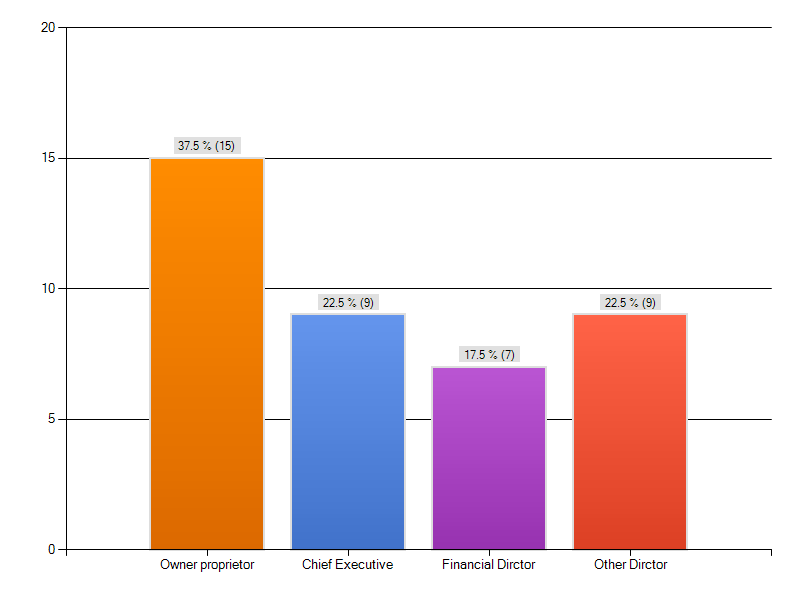
For the survey, we only selected the executive level participants. Above graph illustrate that out of 40 participants, the majority with total 15 participants are the owners / proprietors of their family businesses. However, second big chunk is of Chief Executive Officers with total number as 9. Besides, 7 Financial Directors participated while the remaining 9 are different other directors. Q1 results indicate that the majority of the survey participants are the owners of the companies. The percentages of Q1 for the owner/proprietor, Chief Executive Officers, Financial directors and other Directors are 37.5%, 22.5%, 17.5% and 22.5% respectively.
What is the company’s legal structure?
Q2 is another basic question to identify the contribution of each legal structure of companies owned by the participants of this survey. Below is the graphical presentation of Q2.
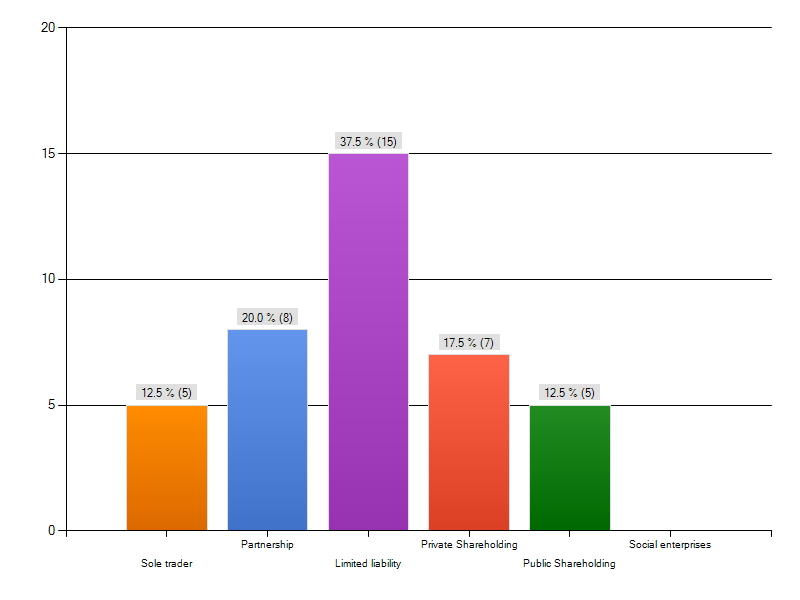
Above graph illustrates that the majority participants (15 participants out of 40) with 37.5% of the total population belong to the companies with limited liability. The second big chunk is of 8 participants with 20% of the population belongs to the partnership businesses. Third big chunk is of 7 participants with 17.5% of the total population belongs to the private shareholding firms while the other two chunks contain 5 participants with 12.5% of the total population each belong to the sole traders and the public shareholding businesses. Q2 results clearly indicate that most of our participants belong to the limited liability businesses.
How long has the business been in operation?
For this survey, it was taken quite seriously to only include businesses that have been operating for at least 5 years or so. However, only a few participants are from the businesses that have been operating between 1 to 9 years. For more illustration, below is the graphical presentation.
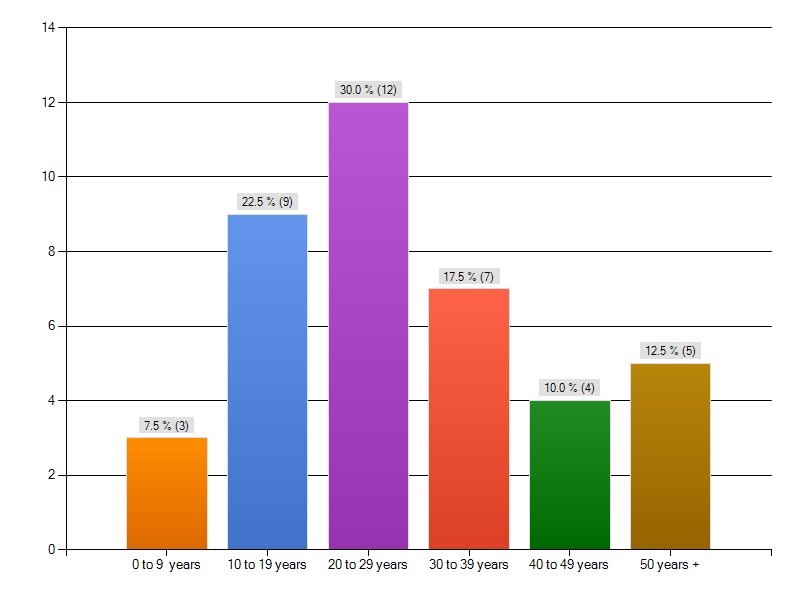
Above graph indicates clearly that the major chunk of 12 participants with 30% of the total participants is from the family businesses that are operational since 20 to 29 years. Second big chunk refers to 9 participants who operate businesses operating in market since 10 to 19 years. Third big chunk contains total 7 participants who own businesses that are in market since 30 to 29 years. Fourth chunk contains participants of companies that are as old as 50 years or above. Fifth big chunk refers to 4 participants (10% of the population) who are in business since 40 to 49 years. While, the smallest classification or chunk refers to the participants who own companies that are in business since 9 years or less. Above illustration reveals that participants are taken from stable companies that have been operating since quite long now. Choosing participants from companies which were established in different years is significant because considering companies that have been operating since similar tenors might not add value to the findings and it could also influence the findings.
Would you consider your business as being that of a family owned business?
Since our topic is all about the impact of diversification on family business, therefore, it was quite necessary to take special care while choosing participants from the family owned businesses. However, below graph reveals if the participants of this survey belong to the family owned businesses.
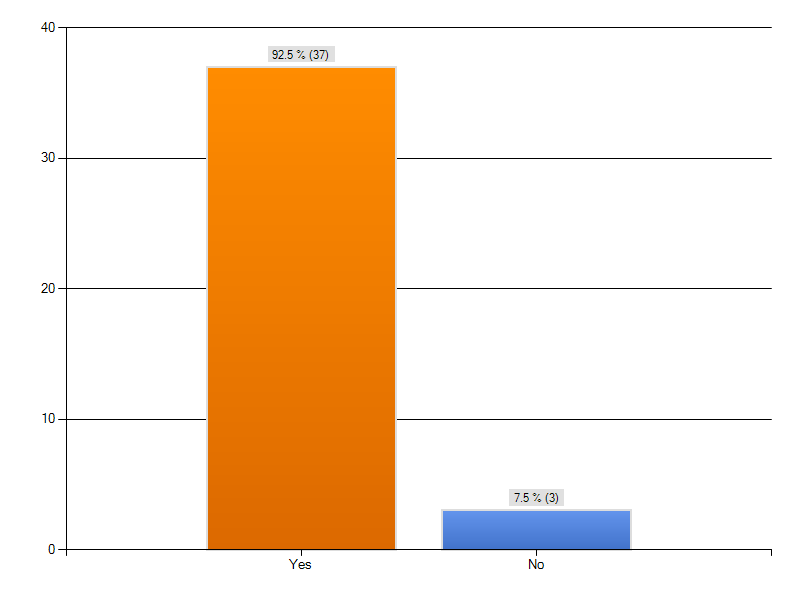
Above graph indicates that 37 participants out of 40 participants belong to the family owned businesses while only 3 out of 40 participants declared that their businesses not as the family owned businesses. Therefore, majority with 92.5% of the total participants reveals that requirement of choosing the right participants has been met satisfactorily.
What is your historical core business?
This question is to make sure if participants are from different businesses as if a major chunk is taken from same nature of businesses, this might affect the findings so it is necessary to choose participants from various fields. Below graph represents Q5 findings that would help in assessing if participants are chosen correctly for this survey.
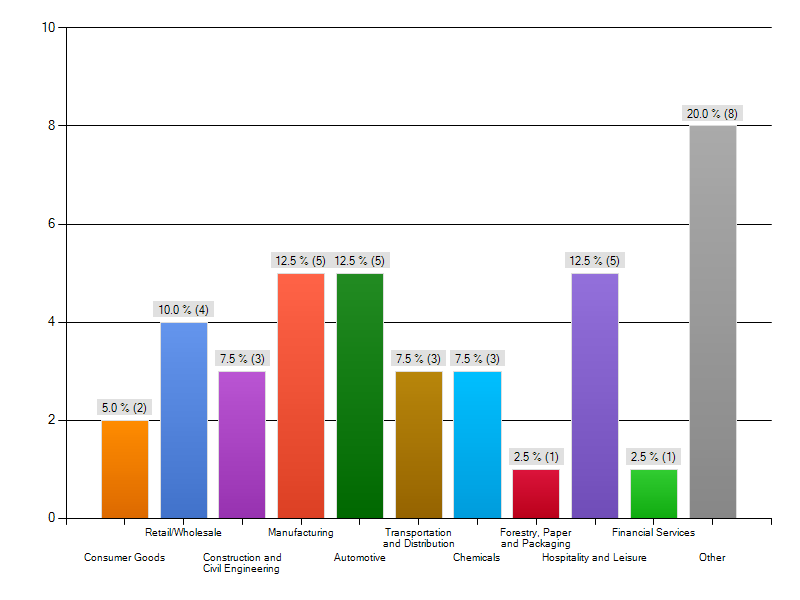
Above graph represents that participants of this survey are taken from various fields with different historical core business including consumer goods, retail wholesale, construction and civil engineering, manufacturing, automotive, transportation and distribution, forestry paper and packaging, hospitality and leisure, financial services and a few others. Questionnaire was sent to executives from various fields to ensure the required balance. Above graph indicates that the task of choosing participants for this survey has been accurately performed.
What participation level does family members have in the business?
For any family business assessment, it is of vital importance that the participations of other family members are identified. Answers of Q6 as graphically presented below.
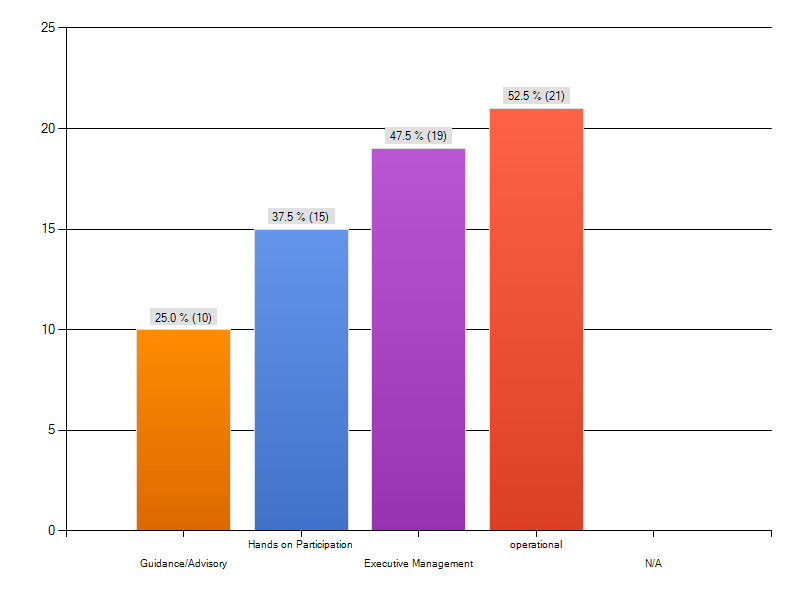
Above graph represents the findings of Q6. It indicates that most of the participants (21 out of 40) with 52.5% of the total population, personally participate in the operations of the family owned businesses. This is a good sign. Results indicate that second big chunk of 19 participants, out of 40 participants; with 47.5% of the total population hold the positions of senior management or executive management. Third big chunk of 15 participants with percentage of 37.5 hold are those who hand on participation while the smallest chunk of 10 participants are those who act as seniors and provide guidance and advisory assistance to the operational executives of the family owned businesses. These participants are mostly the seniors who actually initiated businesses but when they turn senior citizens, they relax and only provide advisory assistance to the existing management. However, for this survey, most of the participants are either operational or the executive management.
What is your current generation / how many generations have been involved in running / operating / managing the family owned business?
This question aims to find out the existing generations involved in running/managing/operating the family owned businesses. This is to check the participation of first/second/third or the fourth generations at present in their family owned businesses. Below is the graphical presentation of Q7 results.
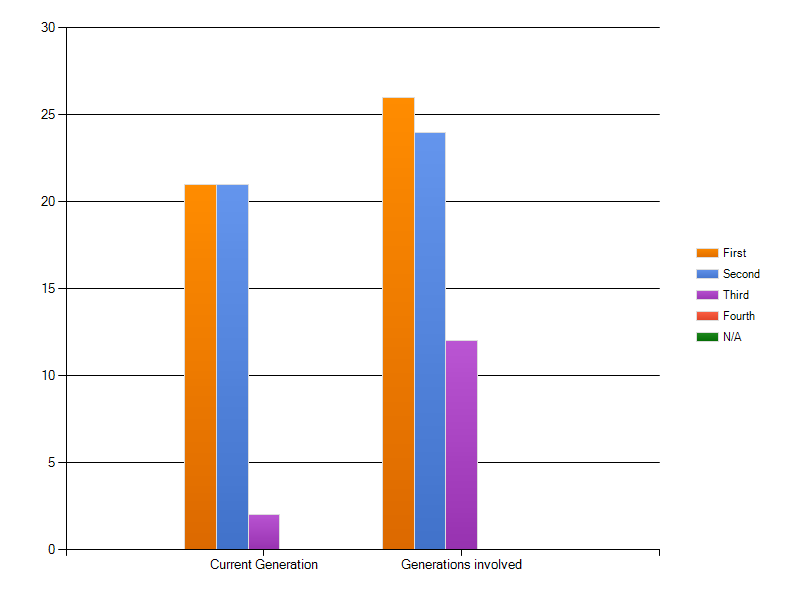
Above graph illustrate that the third generations of all our selected participants’ businesses are not significantly participating in any operational role of their family owned businesses. The percentage of fourth generation is 0%; the participation of third generation is 5% in the current execution. However, the participation of first and second generations is equal, active and significant in the current executing/operational roles of their family owned businesses.
Second part of Q7 indicates the generations involved in overall establishment of their family owned businesses. Surprisingly, results illustrate that majority of the individuals involved in the establishment of their family businesses belong to the first generation. With a little difference, the second major chunk is of the individuals from the second generation involved in the establishment. However, the third generation contribution also seems active in the establishment of related family owned businesses.
Do you expect a change of hands (generation) will occur? And if yes, when?
This question has been included to see if the change in executing generation is expected. Below is the graphical presentation of Q8.
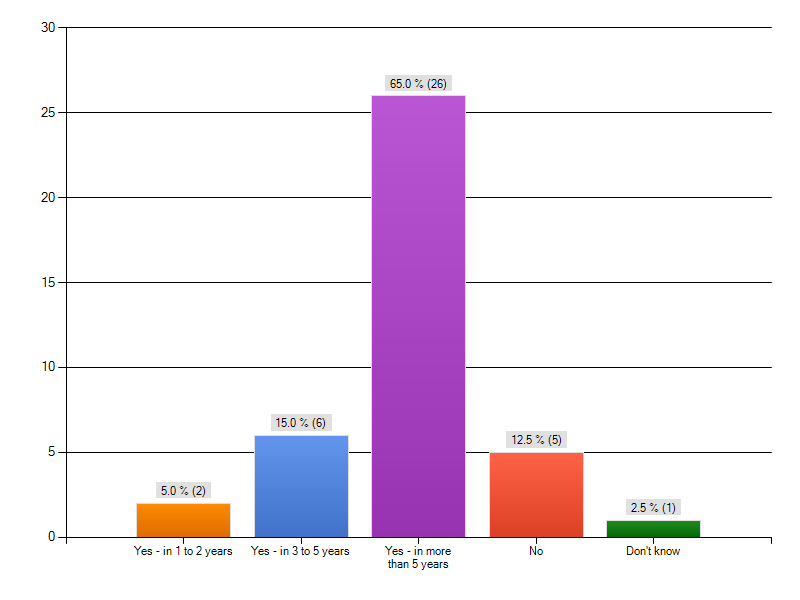
Above graph shows that most of the participants (26 out of 40) with 65% of the total population believe that the change is expected in five years or more. 6 participants out of 40 with 15% of the population believe that change is possible in next three to five years. However, 12.5% participants (5 out of 40) believe that change is not expected at all. Two participants think that change is possible in next one to two years. While only one participant refused to answer and ticked the option of don’t know. Results clearly indicate that though it is a family owned business, change is expected in five years or more. This also means that current generation is quite involved in business affairs and participants (representing population) do not think that they are exhausted yet or it’s a time to pass on the charge to the next generation. They still tend to finalize and execute the system for next 5 years or so, depending upon their willingness and depending upon their perception of assuming the next generation as ready to take the charge. As normally, it takes time to once finalize to transfer the system to the next generation, and even if seniors think to transfer, they still need to work hard on training the next generation by working with them for a few years.
Would you consider your company as diversified?
This question is to test if the participants are from the companies that are diversified. This question has also been tested on the same population of 40 participants. Responses are as under:
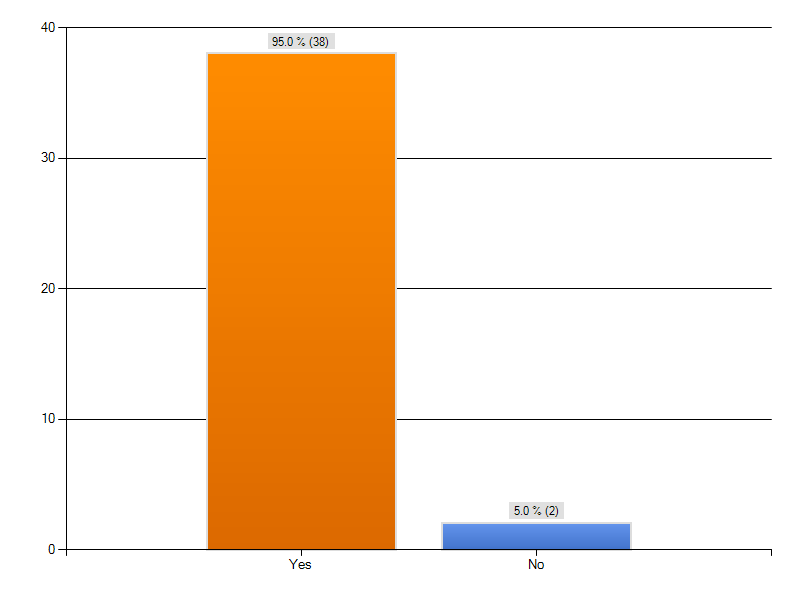
Above chart illustrates that 38 out of 40 participants (95% of the total population) declare their businesses as diversified. Only 2 participants negatively responded to Q9. Results of Q9 clearly illustrate that majority participants are well selected for this study as the topic revolves around the diversified family owned businesses.
Do you own or operate any other businesses?
In order to verbally cross check if the participants of this survey own any other business, Q10 has been tested over the population of 40 participants. Below is the graphical presentation of Q10.
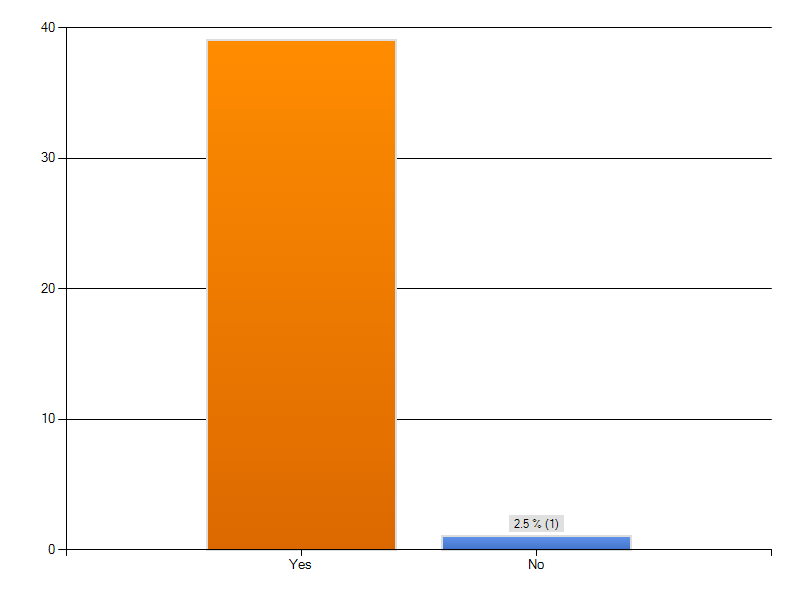
Out of 40 participants, 39 participants declared that they own other businesses as well. Only one participant replied in negative. This indicates that most of the participants own other businesses too.
What level of control do you have on the other businesses?
In order to identify the participants’ level of control, Q11 has been tested over the same population. The results are graphically presented below:
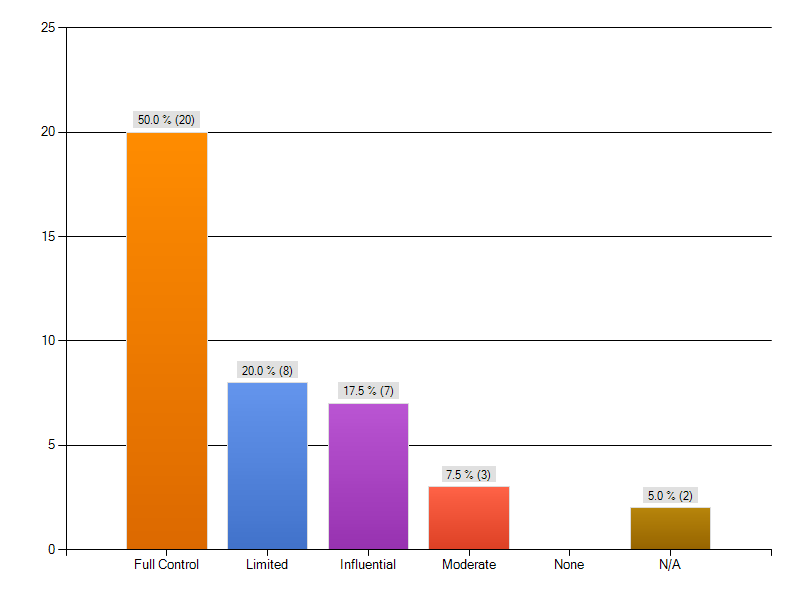
Q11 results clearly indicate the influence of participants on their other businesses. Above graph clearly shows that around 50% of the population, total 20 participants have complete control over the decision making of their businesses. Second big chunk of 8 participants with 20% of the total population have limited control and influence over the overall decision making of their other businesses. 7 participants with around 17.5% of the population stated that they do not have the complete power but their suggestions are influential. 2 participants with 5% of the population refused to comment while no one selected the option of none. Q11 results clearly indicate that being senior directors or executives, they have certain limits to influence the decisions. However, 50% of the executives (mostly the sole traders) have 100% control over the overall decisions of their businesses. Q11 clearly indicates that after all, their suggestions matter a lot and they can play a vital role in taking decisions for the positive or negative future of their companies. The influence is there and cannot be neglected.
What was the primary motivation for diversification?
Diversification is considered for some reason. There could be several reasons for looking forward to move with diversification in businesses. Q12 results would help a lot in identifying the most common motivation for diversification. Findings are graphically presented below to present a better picture:
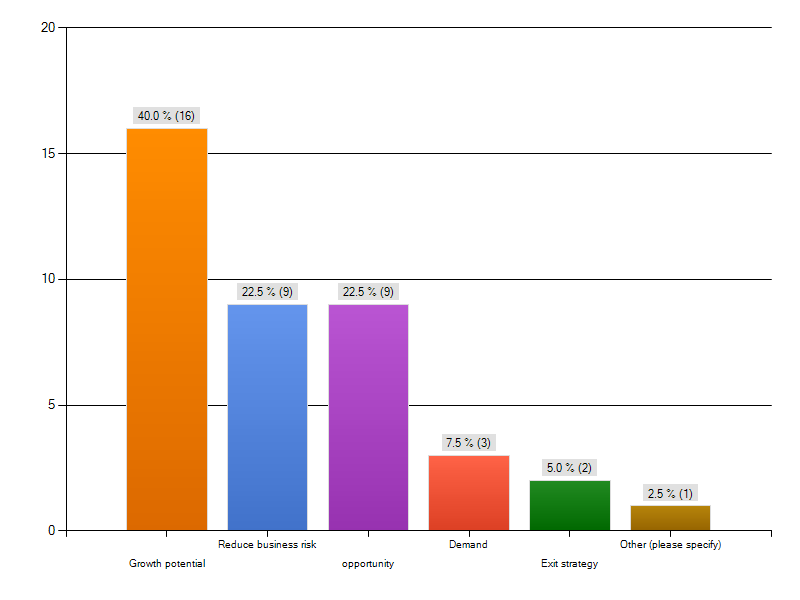
Above graph reveals that 16 out of 40 participants, with 40% of the total population, considered diversification for the growth potential. 9 participants with 22.5% considered diversification to reduce business risk. Again, 9 participants with 22.5% declared that they considered diversification by considering it an opportunity. 3 participants with 7.5% of the total population though it was a market demand that led them going for diversification. Two participants with 5% of the total population took it as the exit strategy while only one participant with 2.5% of the population ticked the option of other but did not specify exactly.
The results of Q12 indicate that majority went for diversification by taking it as the growth potential. With this result, we can assume the trend of diversification is adopted for the sake of business growth.
Would you consider at the time of diversification, that your core business reached maturity?
Another aspect of diversification could be the maturity of one’s core business. At many places while reviewing the literature, it has been found that one of the reasons to go for diversification could be the maturity of one’s core business. However, to test it practically, Q13 has been designed and tested over the same population. The results are graphically presented as under:
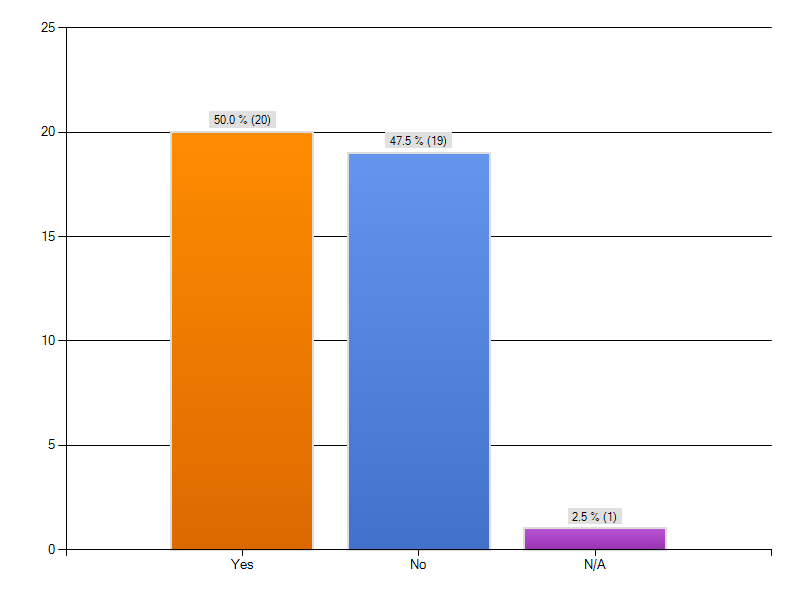
Above graph indicated that 20 out of 40 participants, 50% of the total population agreed with the fact that they considered diversification as their core business reached maturity. 1 participant (2.5%) refused to comment while 19 participants denied Q13. This seems a tough fact to analyze as there is just a difference of one point from yes to no. However, for Q13, it is not wrong to say accept the statement that due to core business reached maturity, diversification is considered.
If your answer to the above is yes, on that stage what was your market position or market share in relation to the core business?
Q14 would help in assessing the reason of diversification up to some extent. Below is the graphical presentation of Q14 results:
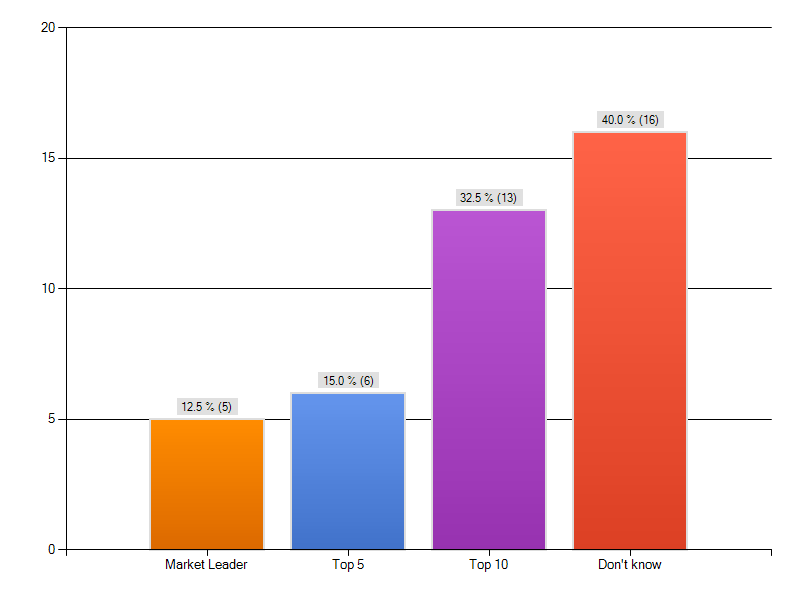
Above graph indicates that participants who considered diversification are mostly under impression that there companies are not in top ranking. Only five participants with 12.5% declared their companies as the market leaders. 15% with only 6 participants declared to be in top 5. The majority selected don’t know option that is a confusing feedback. Above results clearly indicate that due to fall in revenue and market status, participants considered diversification because they think that their core businesses reached maturity.
Once diversified, did the process of diversification continue to take place and if yes in which frequency?
After diversification for the first time, process of diversification begins to take place. To check its frequency, this question has been designed. Below are the results.
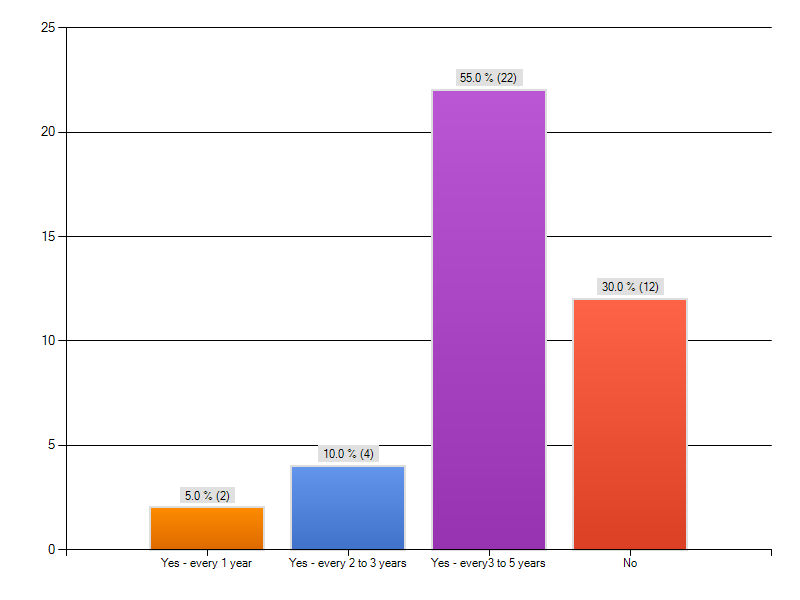
Above graph shows the trend of majority cases. 22 out of 40 participants stated that once diversified, diversification process takes place in every 3 to 5 years. 12 participants stated that it is not necessary that once diversified, diversification begins to take place. 4 participants stated that diversification takes place every 2 to 3 years, while only 2 participants (5%) stated that it occurs every 1 year. However, results influence us to believe that once diversified, diversification begins to take place every 3 to 5 years.
Did the diversification process leads to organizational structure change and if yes how?
The process of diversification influences the organizational structure. However, in large organizations, change is not observed as such. Q16 has been tested over the same 40 participants. Results are graphically presented below:
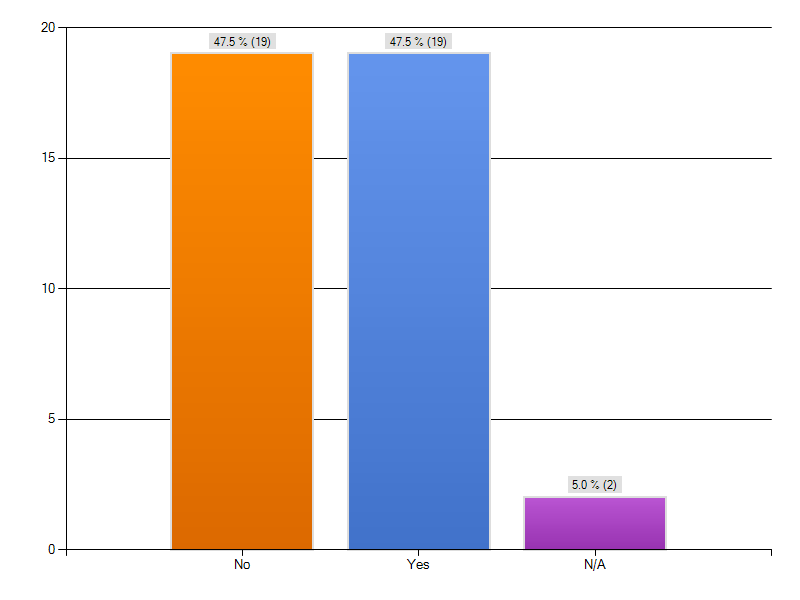
Above results do not present a clear picture as out of 40 participants, 2 participants refused to answer anything. Out of remaining 38 participants, surprisingly, 19 participants chose the option of Yes, and 19 participants selected the option No. Literature review indicates that up to some extent, diversification does impact the organizational structure but processes in the large organizations do not really lead to the change in organizational structure. However, in research part of this study, we cannot really say anything as results are neural.
Do you believe that the “larger organization” has affected the internal controls and flexibility of the business?
As an organization grows, internal control is affected so as the flexibility. To test this point, Q17 has been tested on the same population of 40 participants. Below are the results:
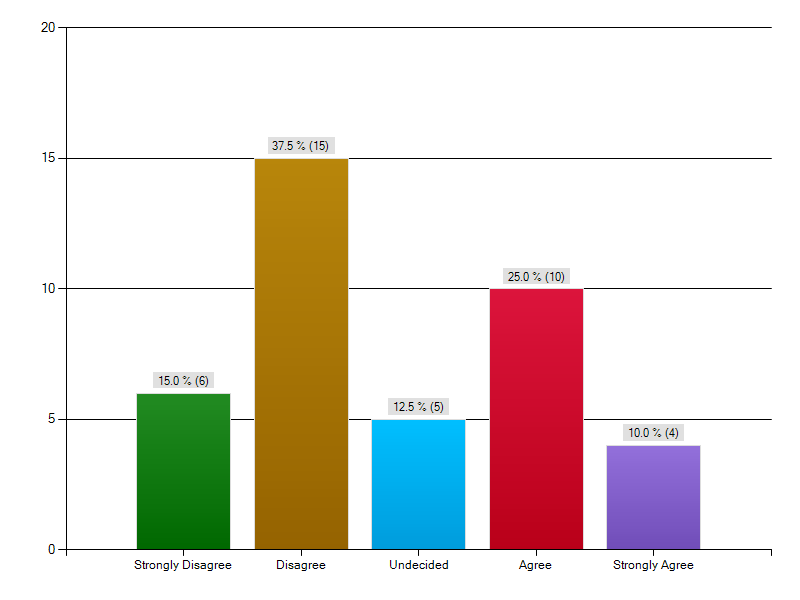
In reply to Q17, surprisingly, 15 out of 40 participants (37.5% of the total population) selected the option of disagree. 10 out of 40 participants (25% of the population) ticked the option of agree, 6 participants (15% of the population) ticked strongly disagree, 5 participants (12.5% of the total population) did not comment, 4 participants with 10% of the population ticked strongly agree option. Results are surprisingly proving Q17 to be wrong. With Q17 results, it has been rejected to accept that the “larger organization” affects the internal control and flexibility of the business
With added business what are the main internal pressures your company currently or will be facing: 1= extremely concerned, 5 = not at all concerned?
Q18 analyzes various internal areas of concern for the family owned businesses to check the level to which participants are concerned about each of the below factors:
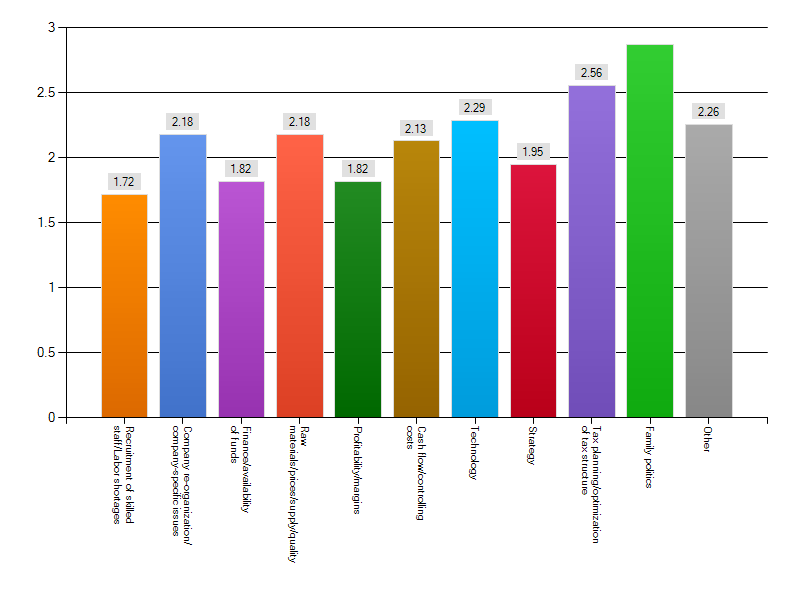
There are different aspects of concern for any family business, such as family politics, tax planning, strategy, technology, operating costs, profitability, raw material availability / quality, financial soundness, company recognition and labor issues. Above graph clearly illustrate that taking an average, all these factors are important and participants are concerned. However, due to the nature of core business, a few factors might not be important for one party than another.
Please rate the level of concern you have regarding the following external factors your company is currently facing or will face in the near future: 1= extremely concerned, 5 = not at all concerned or will be facing: 1= extremely concerned, 5 = not at all concerned?
Q19 analyzes the various external areas of concern for the family owned businesses to check the level to which participants are concerned about each of the below factors:
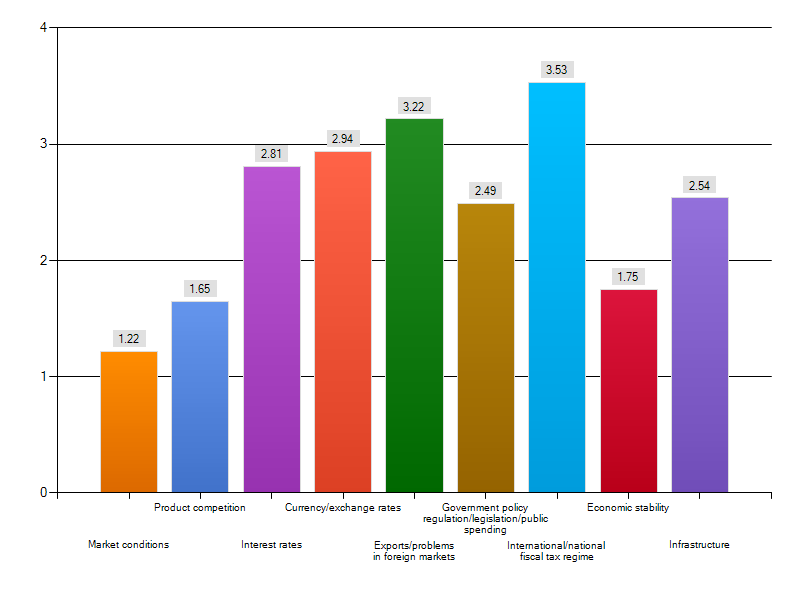
Market conditions, product competition, interest rates, currency exchange rate, export problems, government policies, public spending, international/national fiscal tax regime, economy stability and infrastructure are also the areas where participants are concerned. However, depending on the nature of business, a few points that matter to company A might not be an area of concern for company B. The participants’ feedbacks illustrate a mix picture where average of all factors are somewhat important but the areas of international/national tax regime, export problems, infrastructure and the currency exchange rates are the common concerns in most of the cases.
Retrospectively would you consider the diversification process as having been an option available or an element of business survival/ was the decision to take opportunity of market demand or more from a strength building perspective, in relation to your competitors?
Results are as under:
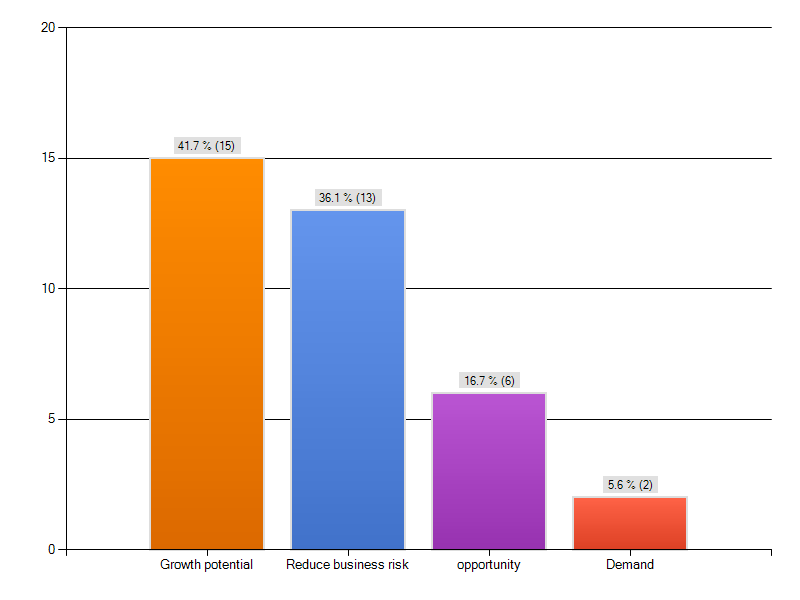
The results illustrate that the decision of diversification was taken by the participants as an opportunity from a strength building perspective, in relation to the competitors for the growth potential, reduction of business risk, opportunity or demand. However, most of the participants emphasized on the growth potential as total 15 out of 40 participants (41.7%) ticked the option of growth potential, 13 participants selected the option of reduce business risk option, 6 participants (16.7%) ticked opportunity option and only two participants (5.6%) ticked the option of demand.
Do you have a succession plan in place?
Succession plan is taken as something quite important in large organizations. Formally or informally, succession plans are observed even in small businesses. As for this survey, participants are taken from different core businesses with different roles and business legal structures, Q21 would help in identifying if the succession plan practice is adopted in most of the cases. Results of Q21 are graphically presented below.
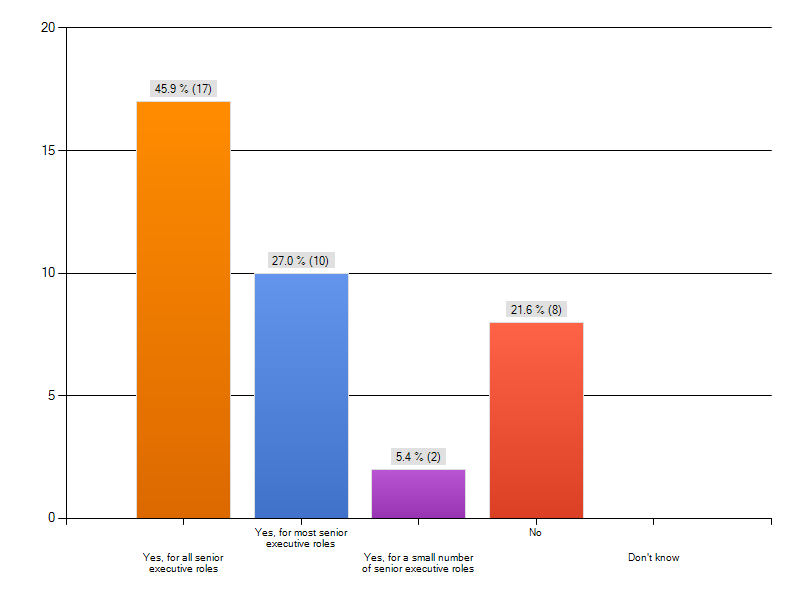
Above graph illustrates that 45.9% of the total population 17 out of 40 participants) responded that they do have succession plan for all senior roles. 27% of the total population (10 out of 40 participants) stated that they have the succession plan for most of the senior executive roles. 2 participants (5.4% of the total population) stated that they do have succession plan for small number of senior executive roles, while 8 participants out of 40 (21.6) declared that they do not have any succession plan. Q21 reveals the importance of succession plan with three fourth of the total population having succession plans for different roles. Majority companies have succession plan for all senior roles while a few have for small number of senior executives.
Do you consider the company as it is today, as being the same family business holding the same culture and ethics or a merely a corporation controlled by members of one family?
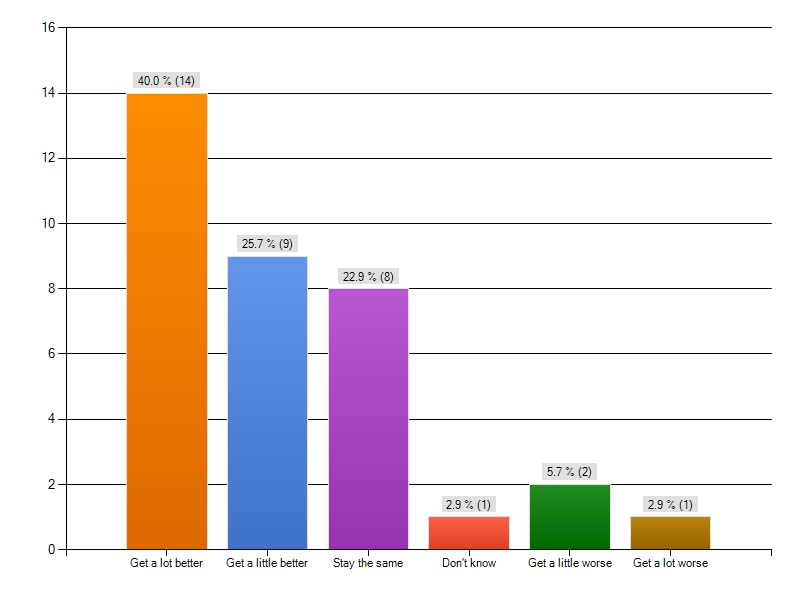
Considering all practices, strategies, structures and family politics etc, when participants were asked to comment if they want it to get a lot better than it is today, to get it a little better, to stay the same, to get a little worse or to get a lot worse. Expectedly, results indicate that most of the participants (14 out 40 participants with percentage of 40% of the total population) believe that it is needed to get a lot better than what it is now. 25.7% (9 participants out of 40) believe that it need to get a little better, 22.9% (8 participants out of 40) want it to stay the same with no change. Results indicate that companies need to improve a lot more than current state.
In your opinion, is corporate governance a tool for optimization or a requirement in the age of diversification?
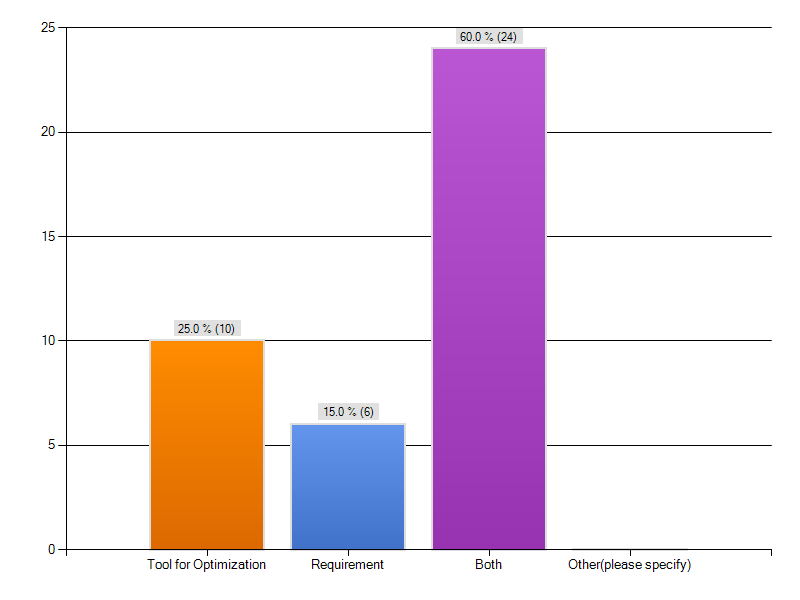
Q23 is one of the most important question of this survey as it is to test if the corporate governance a tool for optimization or a requirement in the age of diversification. Tool for optimization and requirement both are required so this question was to test it practically. 24 out of 40 participants (60% of the total population) take both as equally important. However, 10 participants (25%) selected the option of tool for optimization and 6 participants with 15% of the total population ticked the option of requirement. Results clearly show that most of the participants consider both sides as important so this has been proven that tool for optimization and requirement both are the important aspects.
If and with corporate governance in place, how would you rate the influential power of ‘Family Concept’ (owners) with respect to that of ‘business rules’ (management) in controlling the business:
To run any business formally to receive good results, companies must have corporate governance in place. However, family concepts might influence the corporate decisions. To test this, Q24 has been designed. Below is the graphical presentation of Q24 results:
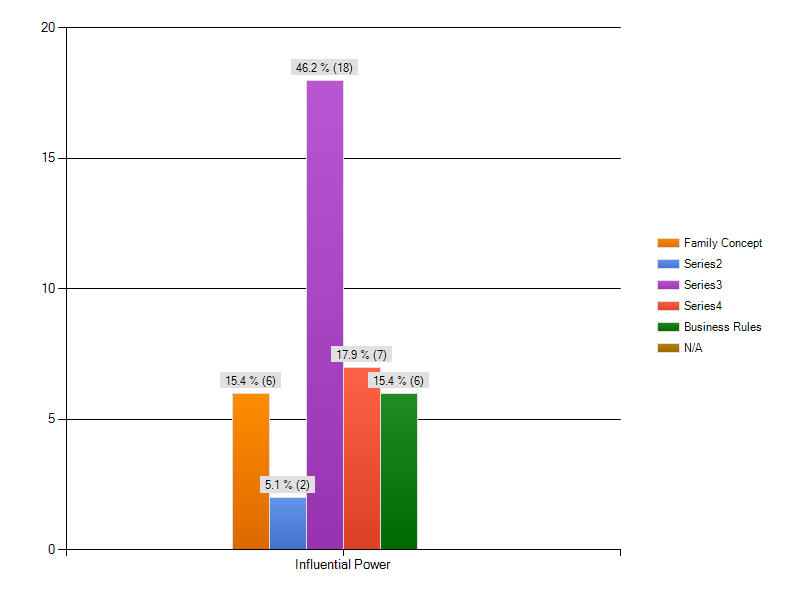
Series 2,3,4 refer to the extent to which participants’ decisions are influenced by the family concept and the business rules.

Above graph illustrates that participants do accept and realize the importance of corporate governance in their business decisions and execution. However, family concept also influence the operations and decisions naturally. The results are dramatically 100% as per the expectations. Majority of the participants (46.2% of the population, 18 out of 40 participants) chose series 3, that means their business decisions are equally influenced by the family concept and the business rules. Other series are even less than half of series 3. After testing Q24, we accept that business decisions of family owned diversified businesses are equally influenced by the family concept and the business rules.
From your experience, did the diversification decision and resulting process have a positive or a negative impact on the core business?
The very last question of our survey and the most important part of testing is to assess what exactly our participants perceived regarding the results of their diversification decision. They are the ones who actually practically went through all advantages and disadvantages that their core businesses faced as result of their diversification decision. Probably, they can better evaluate the situation and its consequences than any other researchers. Below is the graphical presentation of Q25 results.
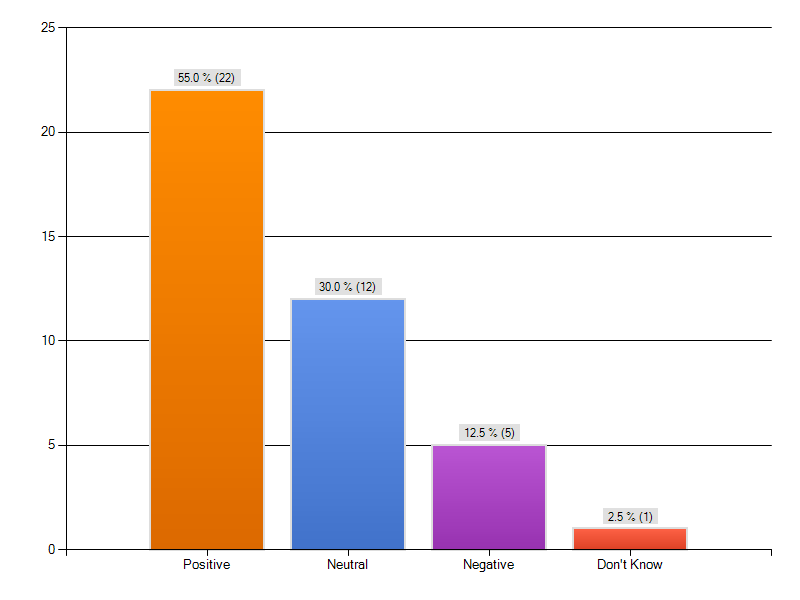
Above results reveal that afterall, when summing up all pros and cons, participants think that diversification is not a bad decision to take. They believe that in the end, results obtained are positive. 55% of the total participants (22 participants out of 40) declared that diversification decision is proven to be positive. 30% of the population (12 participants) believes that if it was not positive than also not negative. However, 5 participants (12.5%) declared that they regret their decision while one could not actually assess if it was positive or negative. Results clearly prove that the diversification decision impacted positively on their core businesses.
Discussion
The analysis of the data presented within the sampling is not to establish whether or not the diversification decision and process was the right or wrong move for the company from a financial perspective, represented by concrete figures; rather the analysis takes form of the identification of specific patterns and general developments, from the perspective of a family business. With addition of the analysis of sectors, the reasoning therefore, is to establish whether these businesses engaging in specific sectors were more likely to opt for a diversification opportunity, whether it be based out of necessity or for reasons specific to that sector or due to the fact that the family business is represented by a more flexible and/or an opportunistic or entrepreneurial drive. The analysis furthermore, addresses each question in depth seeking out any specific general or major consistencies across the sampling, in order to understand how the strategic decisions and planning therefore, have affected the business on a post diversification basis. The analysis revealed that additional issues such as that of succession and continuity most definitely needs further thought on the part of the business that wishes to create a sustainable and long-term future.
Management of the companies in their current forms, with respect to the involvement of the families concerned revealed that the majority of the businesses are merely guided by existing family members, with a low level of participation in the actual daily operations and running of the business concerned alone. Of the families that are still involved with the businesses 52.5% are solely involved in running the business in terms of daily operations, and with 25% of businesses are solely maintaining more of an oversight role from a guidance perspective. Interestingly, the businesses sample showed effective participation in both the aspect of guidance and direct involvement of the managerial and operational duties.
Hence, the entire sampling is still seen as being involved in the business in one way or another although the post diversification situation seems to reveal that the majority of companies that have undergone such a process has resulted in an involvement of the actual workings of the business on a daily basis and guidance in a different context, which translates to an effect on the autonomy of the business after such a process and decision being realized to the extent that such autonomy is in fact reduced accordingly. This may well be confirmed by the company structure that the business is currently represented by, and based upon the specific sampling, 37.5% are Limited Liability Corporations, or the equivalent with the remaining 30% being that of a public or private holding company. Therefore, the structure of the company, of which the LLC appears to be the most popular is represented within this majority and is based upon the company ownership also being protected in their private capacities by such company structure. In addition to these possibilities of changing the company structure to suit the needs of the company in the diversification process, this may well be undertaken due to the fact of adding additional partners or shareholders to meet the requirements of financing such a diversification process and expanding the business albeit on a product offering or on a geographical basis.
Business Age and Generation Involvement Analysis
An important aspect of the research reveals the average age of the businesses surveyed. The importance of this is to reveal that the businesses that have undergone diversification have been in operation for more than 3 decades, and according to some of the responses, had the company not undergone any diversification, the entity may well have ceased to exist rendering the company null. Hence the choice of diversification could signal the survival or the need to survive via this decision, and had the decision not been made the company would no longer be in existence today. Analysis of the various business, represented below, reveal the following relevant data:
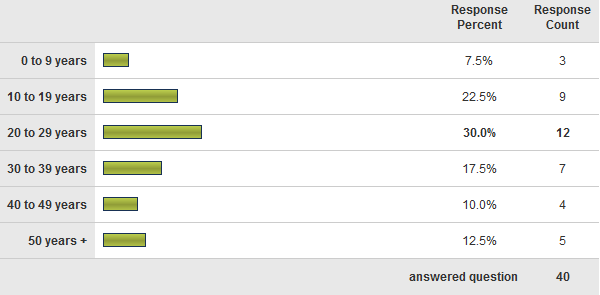
The average response percent is 16.7%; the median of our collected sample is 15 years. The above analysis serves to highlight the fact that only 45.45% of the sampling are above the average business age of 52.41 years, with the balance being represented by 30% of business respondents being below the median age. One may translate this issue of diversification into possible globalization issues and opportunities that have arisen over the short to medium term, in that the younger business may well have had greater opportunities to take advantage of such globalization, in which a diversification process and decision must have been undertaken, as compared to the older companies who might be more established and unwilling to engage in such diversification.
The sampling used here, with specific reference to the age of the business is lower than that indicated by Poutziouris (2006) in analysis of various nationalities and the average age of the family businesses, such as in Japan the median is 145.22 years, whereas in China the median of the family business age is 52, and in the United States it is quoted as being lower than that. The sampling revealed that the average age as at the present time is 16.67% years which can be translated as being just below 35.75% younger than that of the median of Chinese family businesses, and almost 77% younger than that of the Japanese median, as reported by Poutziouris.
The issue of how many generations has been involved in the business further serves to confirm the lifespan of the business to present dates, and although this may serve as a confirmation issue, it does raise another point which although beyond the scope of this paper, is well worth mentioning. The issue of succession within the family business is just as an important factor to the success of the business and plays a vital role in terms of the decision making process and future success and longevity of the business. Cater provides that the family business is faced with additional family issues that need to be taken into account to ensure the future of the business, whilst also dealing with external factors and situations (Cater 2006).
In dealing with the family issues notice must be given to the satisfaction of the older generation whilst preparing the younger generation for succession and to take the leadership and control of the business into account. The sampling in this analysis revealed that a median of 1.67 generations have been involved within the defined family business indicating that the second or third generation is currently involved with or has been involved in the management and control of the company concerned. It is important to imply that the sampling conforms to a longer standing representative sampling in terms of the involvement of the generations, as well as the age or lifespan of the business. Cater further indirectly provides that succession in the family business is arguably more vital to the success of entity than the process of diversification, and therefore, such succession factors and attention to this topic needs further insight and analysis. Specific research figures provided by Cater include the fact that “only 30% of all family firms survive the succession from the first to the second generation, only 12% survived the succession to the third generation, and only 3% survived beyond the third generation.” These quoted figures serve to highlight the importance of the preparation of succession regardless of diversification being undertaken.
Sector Analysis
The reasoning behind the analyzing of the sectors within which the sampling was obtained is to establish whether or not diversification is more relevant to specific sectors or whether it is a relatively widespread phenomenon across all industries.
According to the respondents, a wide variety of sectors are represented here. However, specific attention should be given to the automotive, manufacturing, Hospitality and Leisure sectors here, in which over 12.5% of respondents is operational in this field. The actual naming of these sectors as well as the percentage breakdown of the respondents is reflected in Table 2 below:
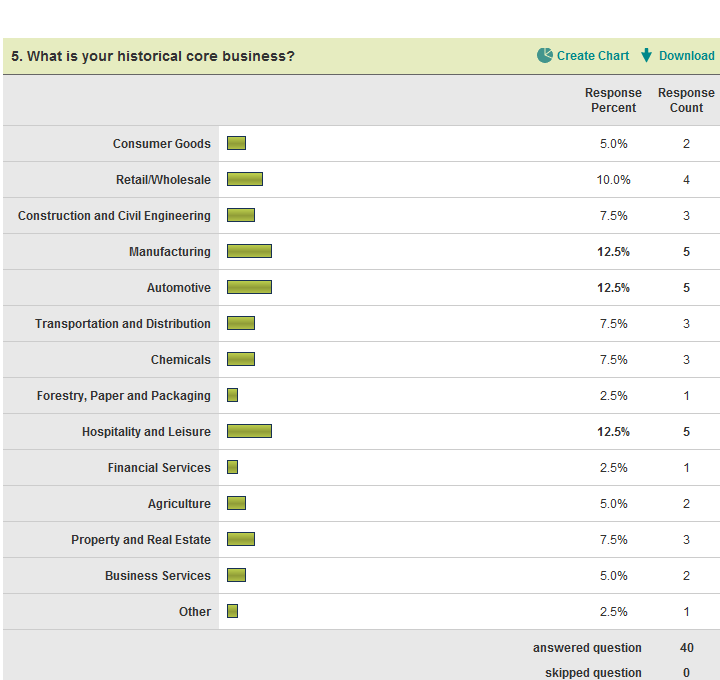
The figures highlighted above further support that the automotive and hospitality industries may also relatively open to the need of diversification for survival or profit maximization for the family business. Upon analysis of the responses of whether or not the market had reached maturity, which may have served as the motivation for diversification, the vast majority of the respondents has provided that the maturity of their respective markets had in fact not been realized, and it was rather from an opportunistic perspective that the decision of diversification was taken. The exception within the sampling was that of the two respondents which had not undergone any sort of diversification, as well as another single respondent who stated that their original core business had become enviable for them, and therefore, the diversification process had been undertaken out of necessity for survival and continuity of the business itself.
At the time of diversification, a number of external factors have been quoted as facilitating the process and motivating the need to take up the additional opportunities, as they had become available at the time of the decision. The fact that the majority of respondents have answered that the diversification process and decision was more of an opportunistic move will Therefore, create a conclusion that the tool of diversification itself is not primarily that of a survival ‘mechanism’ but rather a tool for optimization and maximization of the business and its potential profits and returns. This does not however, take away from the fact that it can be based on survival needs alone, as is represented by five of the respondents within the sampling.
It should also be noted that although some of the sectors may well overlap from a macroeconomic definition, these sectors are deemed to be sufficiently different to warrant separate analysis and categorization, as per Table 2 above.
A further interesting fact revealed on the analysis of the questionnaires, and specifically relating to the businesses that have undergone diversification, represented by 39 of the 40 respondents or the equivalent of 97.5% of family businesses who participated in the study have additional business interests outside their core, all original business sector. This raises the point that perhaps the diversification process further acts as a catalyst for the family business or small business owner in realizing the value of diversifying their investments across a variety of sectors to reduce exposure to external forces that are relevant to specific sectors.
Control and Shareholding Interest
Although this area may overlap slightly with that of the previously mentioned question of involvement in the business, it is somewhat different, it represents the ownership of the entity under question, and serves to reveal the involvement of external stakeholders from a partnership, investor roles in the structure of the company and how it has taken in the form of structure. This area of analysis further reveals to what extent the original family ownership unit is still involved in terms of the oversight and leadership of the family business, as well as any other external decision-makers with stakeholders as mentioned.
In addressing the ownership factor of the companies and sampling, regardless of the legal structure the majority of respondents are either wholly owned or a majority shareholding is held by the original family, which once owned the business. Therefore, the conclusion can be drawn that despite any diversification within the business itself, control and majority ownership was retained across the spectrum of the sampling, with all companies remaining under the control of the family concerned. This may be translated into the fact that upon deciding to undergo such diversification the company is contained within the sampling did not elect for external funding, such as the incorporation of the partners, but may have funded the diversification process generically or via traditional financing mechanisms, such as bank loans or personal investment from within the family. Another key factor realized from the analysis of the specific control question, realizes the fact that the companies concerned have retained their leadership and oversight of the families concerned, albeit by a managerial or directorship channel.
Diversification Motivation
Analyzing the reasons for diversification within the sampling, highlighted the fact that many of the businesses surveyed had not achieved maturity within their core market, but had rather identified opportunities either related or unrelated to their core market, into which the companies had entered. It appears that the motivation had been primarily growth potential. However, up to some extent; it is also a case of survival or an opportunity. Companies diversify within their core market or into sub-sectors of their core market, claiming that a more holistic approach, in terms of logistics and the supply chain within their respective markets had offered an opportunity to not only reduce costs, but rather add to the company revenue, as well as forming a reliable base within which each business unit could operate on a successful basis. Another two of the businesses surveyed did however; stipulate that the motivation for their decision-making process, specifically in the automotive market, was to counter the instability being experienced within the sector at the time. In addition to stabilizing their revenue streams the decision was undertaken to seek out alternative business opportunities to guard against future possible market fluctuations, in an effort to stabilize overall income across the automotive market, as well as the new sector in which they chose to operate at the time, which is that of financing and related activities.
The primary motivation for having undergone diversification in whichever of the sectors mentioned above is apparently that of the addition of revenue, as well as an alternative source of revenue to the companies concerned, therefore, motivating the opportunistic or entrepreneurial underlying spirit evident within the family businesses surveyed.
With the exception of the company that confirmed their core business was no longer viable, the majority of companies had achieved relatively high market positions, in relation to their core business, which further supports the fact of the opportunistic nature of the diversification process as described above. According to the respondents, 32.5% enjoyed a top ten positions within their market, at the very least within their regional markets; and in considering this market position, it motivates the conclusion of entrepreneurial decisions, as well as taking advantage of opportunities presented at the time and therefore, motivating the decisions and processes of diversification within their companies. Even the single company claiming that their core business was no longer viable, had enjoyed a top four positions, the necessity for such diversification had proven to be not only viable but, essential for the family business to continue as a going concern.
Continued Diversification
In order to establish whether the diversification process was a once off or a continued process within the sampling, the question was posed as to whether the process had continued or was a once off decision and process. Their responses indicated that majority with 50% of the participants believe that once diversification take place, it occurs every three to five years. 30% doesn’t call it necessary to experience it ever after once. One may interpret this as an equal representation between those that continued diversification and those that did not providing an equal amount of companies representing each decision. Of those companies that continued the diversification process, these companies diversified into different sectors away from their core business model or market, whilst some diversified within their area of specialization. This fact may represent a true diversification and risk reduction, in seeking opportunities outside their existing businesses, whilst encouraging additional revenue streams from alternative sources.
Organizational Structure
The fact as to whether diversification can or does lead to the changing of the organizational structure is important in relation to possible changes in the shareholding and ownership, as well as ultimate control of the company itself and more importantly by whom. Such structural change may be brought about by the fact that the company may well have needed to raise funds to facilitate the process of diversification, or perhaps even the acquisition of necessary intellectual capital or related expertise.
A total of 47.5% of the sampling indicate that the organization did in fact undergo structural changes, but not due to the necessity of raising funds or acquisition of mentioned expertise. Rather, the approach of the organizational change was in order to increase efficiency in terms of management of the various sectors of the family organization, including that of the newly diversified operations. Although a majority of limited liability companies are represented within the sampling, this decision had been made from more of a control and oversight perspective than that of having to undergo such structural change in the diversification process, and is more reflective of a rationalization effect from a management perspective.
Of the companies that underwent such structural change, and went the public listed company route, which is represented by 12.5% percent of the sampling the family maintains control over the company, despite public listing and occupy positions as board members, whilst retaining majority shares within the company itself. Therefore, if one considers the process of publicly listing a company is primarily motivated for the purpose of raising funds for the growth of the business the mentioned percentage of the sampling confirms that less than a third of the companies surveyed required such financing, and even in the incidence of acquiring the necessary funds for expansion and diversification, control was still retained by the family concerned. This was achieved via the retention of a majority shareholding, which in turn provides the family the opportunity to install board members as according to their majority vote, which in this instance maintains that family influence on of the original organization.
One may furthermore, conclude that by conducting the restructuring, or structuring of the new entity in such a manner the issue of autonomy or less autonomy within the family operated or owned business is overcome by a majority shareholding strategy, which although the company has to abide by a specific corporate governance rules and related items, this process serves to maintain the actual control in terms of the strategic directions of the company concerned.
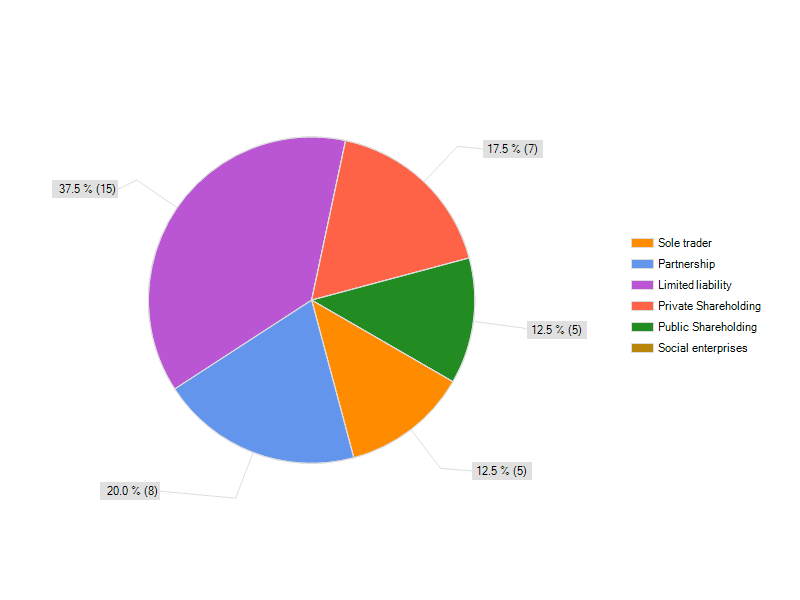
Figure 30 above serves to illustrate the nature of the business or company structure on a post diversification basis. Each company structure has its own merits, and as previously discussed according to the sampling the manner in which the companies who elected the plc route still retained majority shareholding which in turn facilitated or facilitates greater control with acquiring the necessary financing for the expansion or diversification process. The limited liability company route, although arguably similar to that of the plc without the public offering of shares in the company, still offers protection to the owners and shareholders within reason, the corporate governance issues may not be as pertinent to that of the plc type of company. The limited liability company option furthermore offers more flexibility in terms of the setting up of the company structure itself, as well as the allocation of ownership portions or shares.
In the process of establishment of an alternative company, the issue of autonomy is once again raised, as well as the flexibility that is associated with such organizational structure. In terms of the sampling of family businesses that have undergone such change, no negative aspects of the flexibilities of the companies were provided, but rather a more positive insight into the controls of the company have been revealed by the entire sampling. Therefore, 100%, or an unanimous vote in terms of the positive effect of such structural change, and specific to the controls perspective was provided by the sampling, which suggests that although companies may experience some sort of apprehension in terms of the perceived change in control and flexibility, this apprehension is unfounded as reported by the response from the market research provided.
Management of Diverse Units
The management of the diverse business units requires necessary analysis in the determination of whether the business units have been separated in terms of management and how the company intends to manage these divisions. This further serves to confirm the nature of strategic decisions and management, whether it emanates from a central decision making unit or whether each business or sector is responsible for their own activities in terms of marketing, promotion, and human resources and so forth. As with any strategic expansion of a company a number of factors will add to the management issues and pressure associated with such management practices accordingly, which in turn needs to be managed either externally or internally.
The sampling revealed a number of different strategies that have been undertaken via the individual companies from the perspective of the various functions and management issues. Although the majority of respondents indicated that such diversification had in fact contributed to the added pressures of management and control, a number of different strategies were employed to address the situation of management and control of the various business units and internal processes.
One of the respondents indicated that family members were put in position to manage and control the various aspects within the business, whilst over a few of respondents used external suppliers and providers to manage certain aspects of the business, such as marketing and human resources, while maintaining control within the business from a management perspective amongst family members and employees. The majority of respondents indicated that systems and policies defined by family shareholders were implemented within the organization to ensure smooth running an effective control on a post diversification basis, while 47.5% of the population indicated no changes on their organizational structure. Many of these decisions, systems and policies stemmed from the initial ethics of the family organization and were carried through into the new business entity, regardless of structure, size and number of employees. This seems to have further contributed to the company’s survival and success in maintaining the original ethics and entrepreneurial drive behind the company itself, based upon the majority response of the sampling.
The use of outsourcing has alleviated specific pressures within which the family members deemed to be better suited to external management, which although remaining under the control of the family business and stakeholders appear to be more streamlined in being dealt with by the relevant professionals concerned.
Retrospective Diversification Analysis and Impact upon Business Culture
The reasoning behind retrospective analysis of the diversification process is to establish whether the respondent concerned conducted such a process on a strategic business option or based upon survival of the business unit itself. Analysis of the decision of diversification search confirmed the necessity of such process, or whether the entrepreneurial drive or spirit serves as the motivation thereof. Although this question has been touched upon earlier within the questionnaire, one may consider this line of questioning as a control measure to fully confirm motivating factors of the process. It furthermore serves to illustrate the positive impact of such decisions in terms of the strength of the business, which one can analyze retrospectively to form the basis of future expansion and related business decisions, in terms of the overall business strategy and direction.
In terms of sampling, a number of respondents confirmed an increase in market share, or business strength based upon their decision of expansion and diversification, both within the relevant business sector in terms of their core business market share, as well as an increased strength from a revenue perspective via diversification into alternative sectors. Sixteen of the respondents, or 40% of the sampling stated that business survival had been a motivating factor, with two of the businesses stating that their core field of expertise had subsequently ceased to exist, hence justifying the diversification decision and process. 22.5% called it an opportunity. 7.5% reasoned it for the sake of demand. The remaining 22.5% stated that the motivation behind such decision retrospectively was to reduce business risk.
As previously stated the primary motivation within the sampling of the family businesses, pertaining to the reasoning and motivation of such strategic decisions in terms of the company’s future is driven by the opportunities presented in the market, and could once again be attributed to the entrepreneurial spirit of the family business with respect to taking up such opportunities. Furthermore, the fact that the reasoning behind the diversification is consistent with the directly presented reasoning previously discussed confirms this mentioned motivation and establishes the opportunistic manner in which the family business operates within the sampling of businesses.
Corporate Governance and Control
The issue of corporate governance and control is specifically relevant to the family business that has undergone structural change and may have resulted in a loss of the initial family values and ethics that are prevalent in the family business due to possible changes effected in order to adhere to corporate governance requirements as stipulated by any relevant legal framework. Butler & Phan provide that “family dominance in the corporate governance structure may strengthen the ability of the corporation to coordinate on decision-making and hence have an impact in strategic interactions with external stakeholders.” (2008 p.10) These places the family controlled enterprise in a possibly stronger position than that of corporations that such family dominance and involvement.
With respect to the sampling of family businesses which participated in the study, around 10 respondents agreed that corporate governance is an effective tool for optimization of the business, represented by 25% of the sampling. 6 participants (15%) saw such governance as a requirement that had to be attended by the business concerned in terms of operational procedures and adherence to regulations, Therefore, not utilizing the issue of governance as an optimization mechanism for the company, but rather seen as a necessity for compliance. The majority of 24 participants with 60% of the population called corporate governance a tool for optimization or a requirement in the age of diversification both.
Poutziouris provides that the issue of corporate governance should be seen as the promotion of the company, or the stakeholders or both (2006 p.322), which should be seen by the family business owners and management as a positive tool and not that of an issue of necessity.
Whether corporate governance has taken over from the initial family business ethic, culture and concept would contribute to the feeling that autonomy has in fact been lost within the expansion process or that of diversification, and hence it would be specifically relevant to the overall feelings or belief of the family unit of whether or not such expansion had facilitated the loss of such autonomy. Within the sampling over, many respondents agreed to the fact that the family unit, together with the original culture and ethic still manages the company accordingly, within the defined rules and issues of corporate governance, and Therefore, do not attribute any major change to the management of a going concern to that of corporate governance. Based on the fact that of those companies interviewed, who are more prone to such corporate governance, family members are appointed to the board of the company concerned, and as Poutziouris provides that the accountability of these board members should be the central theme of corporate governance and not that of the structure itself (2006 p. 322.).
Based on the findings of the surveys, regardless of company structure and whether or not the issue of corporate governance is seen as an optimization mechanism that born out of necessity for adherence, the family unit together with the original ethics, culture and internal controls seem to dominate across the entire sampling.
Diversification – Positive or Negative
The view of whether the diversification process was positive or negative is to provide an insight as to whether or not the risk or perceived risk of following such a path in terms of business strategy did in fact achieve the goals and objectives of the initial decision of such a process, and whether or not the family business as it stands today is in a better or worse off profession and position as a result of such actions, or in actions.
The figure above highlights the perceived positive impact of the respondents within the survey, represented by the majority of the respondents specifying that the overall impact was in fact positive. Interestingly enough 55% of the respondents found that the diversification process was positive, 30% found it as neutral and only 12.5% found it negative to their businesses. However, one did not participate in above three options. However, this was offset by the success achieved in those specific sectors and thereby contributing to the positive effect of such diversification. The 12.5% that found the process to be negative shared similar views to those responses that found that both positive and negative simultaneously, in that their attention and efforts were diverted away from the original business. One respondent is represented in the 2.5% as being not applicable due to the fact that the business had not undergone any diversification but, had undergone expansion in their core business. 55% responded that diversification had positive results.
Conclusion
In conclusion of the analysis of the questionnaires, sufficient response was provided by the respondents, in compliance with the line of questioning providing an insight into what the family companies had undergone in terms of a diversification decision and resulting process. Findings were further confirmed via control questions, with the majority of decisions being motivated by strengthening, revenue generation or opportunistic benefits and beliefs behind the diversification process. It is furthermore apparent that the family ethic and control survived the diversification process, and are instilled in the new company regardless of the legal structure or family level involvement.
The issue of the autonomy is apparently also been dealt with via the allocation of shares in specific amounts and by specific structures to ensure that majority control and leadership remains with the family concerned. It appears that the majority of the respondents had facilitated such diversification via their own funding mechanisms, as the majority of respondents indicated a limited liability company structure, implying that such financing was obtained on an internal basis or via banks, but not by offering shares within the company on a public basis. The exception to the rule within the respondents was a single company, which although they elected to publicly list their company, the majority shareholding was retained by the family concerned, with the overall control vesting within the family by the appointment of family members to the board of directors. Regardless of actual involvement within the company on a post-diversification basis, the original family members still retained some level of control or involvement, albeit from a supervisory or oversight basis.
Lessons Learned
Contradiction with the Theory
Based upon the primary part of the research that clears indication of the majority of businesses diversifying was due to that of favorable market conditions, and entrepreneurial risk and reward type action, whereby the family businesses were taking advantage of opportunities that presented them within the market. This type of entrepreneurial action, according to Drucker (1985) should in fact not be confused, or classified within the same field as innovation, as the author claims that such action of taking the business out of its core field of expertise is normally unsuccessful. However, the actual responses of the sampling indicate that this is not the case. On the one hand, such innovation is claimed to be unsuccessful, whilst primary data reveal that the businesses are still thriving to this day, with interested stakeholders being satisfied with the growth, expansion and continuance of their relevant businesses. One has to now consider that although according to the academic side of the argument, in terms of such innovative actions resulting in successful business practice, the actual primary research data indicate the opposite, which is represented in the fact that the business continues to operate today.
Involvement of Generations
Although within the sampling the majority of the businesses surveyed seem to be satisfied with market position and growth of the business, together with the physical involvement of a number of generations of the family, it is expected that issue such as succession and continuity are due to arise. This is said to do that, but the involvement of multiple generations indicate that the company is still largely under the leadership and control the original generation, and although the involvement of the secondary, and in certain instances tertiary generations have been encouraged and implemented, the fact that the original generation is still involved in the leadership of the business points to what mentioned authors described as one of the opposing forces still in control of the business, referring to the original generation. This founding generation in all likelihood has concerns of the continuity of the business, as described by the authors, and whilst these family businesses run the risk of becoming one of the statistics of succession failure, as previously described, then suitable succession planning and implementation needs to be effected as soon as possible. Whether or not the secondary opposing force of the younger generation becoming impatient or tired of waiting, was not revealed within the sampling; however, it has highlighted within the secondary research of the organizational theorist, and it is indeed well worth noting.
Corporate Governance as a Tool for Optimization
Corporate governance, although it may not be a requisite for a privately owned firm, is well worth encouraging within the family business to be used as a tool for optimization, inclusive of the management of resources, from all perspectives including that of human resources, financial resources and management resources. Such governance creates a perception amongst external stakeholders, in more ways than one might be led to believe. Typical of this issue is that of the generational demographic, of what the marketing fraternity referred to as generation Y, where they seek out employers, producers and service providers with strong ethics and solid track records, this is an implication upon the perception of the business regardless of whether it is family owned and controlled or publicly listed. Therefore, the issue of corporate governance cannot only be used as a management tool, but marketing and branding tool as well. These factors further contribute to the continuity of the family business, over and above the issues of succession, diversification and sound management and leadership whilst providing a sound framework for the management of various resources within the family owned and controlled business.
The Need For Effective Management Controls
There is no doubt that the respondents within the survey realize the need for effective management controls, as was witnessed by the majority of responses indicating that specific legal structures were required in order for the business to progress accordingly. Despite the fact that the governance issues are seen as a pre-requisite, this has doubtfully been implemented across-the-board of the sampling. Based upon the fact that average, or median generations operational within the sampling is that of 1.67 generations, the sampling reveals that perhaps the businesses are fairly young, further indicated by an average age of almost 17 years. This raises speculation of the succession issue again, despite the fact that legal entities have been structured correctly, such as the limited liability companies and the public companies is provided by respondents in the study. The mere creation of a legal entity does not ensure the sustainability of the company, and as described a wide variety of issues, inclusive of attitudes must be addressed with respect to the succession process, as well as that of the governance issues mentioned and discussed. The recognition of the need of legal structures in order to protect the families concerned is recognized and a valid step forward, with the next step being that of ensuring mentioned sustainability and continuity.
Impact on Family Business
Furthermore, based upon the contribution that family businesses actually provide to the economy as a whole, combined with the fact that between 92.5% of all companies are family owned and/or operated, perhaps national legislators should seek to educate family members, currently controlling businesses as to the issues specifically pertaining to corporate governance, including social responsibility, as well as that of succession and continuity in order that the succession success ratio increases thereby reducing the possible downfall of established businesses on a post-succession basis. In a study conducted by KPMG and Family Business Australia, government regulation and employee issues were contained in the top four challenges faced by family business, which are highlighted in the above in terms of instead of a regulation based environment, the government should seek to provide greater encouragement and or initiatives for the family business, perhaps for those who adhere to specific corporate governance issues, which in turn may well address the other challenge of employee issues as expressed in their research and survey response (Family Businesses 2008). Hence, issues such as that of governance may well go a long way in not only promoting social responsibility, succession, continuity that filters through to issues of human resources and ultimately financial aspects of the company too.
Diversification in Family Businesses
One of the most predominant issues that bear highlighting here is the contradictory evidence provided by various authors as well as that is revealed within both the primary and secondary data analysis and research. This could be attributed to the private nature of the family held business, or that of the vastly diverse areas within which these family businesses operate. Based upon the significant taxation that many of these companies are exposed to at some point it is without doubt understandable as to the very nature of the retention of private information and the lack of willingness displayed by many respondents within this study.
Entrepreneurial Trait And Opportunistic Perspective
In closing the sampling reveals that many of these family businesses, together with the founding family members display a specific entrepreneurial trait in the taking up of opportunities as presented by the marketplace at the time and although a variety of academic authors and so-called organizational theorists may well describe certain issues such as innovation and entrepreneurial-ism should not be confused or even likened, as in the case of Drucker (1985), the fact that these businesses represented in the sampling continue to operate and have continued to diversify and grow, whether it be from an organic or externally funded basis, tends to negate the views of authors such as these.
Granted there are specific, and extremely relevant case studies that exist and which highlights issues of succession, continuity and sustainability which may well be lacking from the perspective of the sampling, or due to the inadequate information provided; the opportunistic nature of the sampling has enabled these corporations all companies whichever the case may be to maintain levels of success and growth, whether it be from an innovative or opportunistic perspective, which in many views is construed as being that of an entrepreneurial nature. Families work for the well-being of the family unit, as well as inheritance of the family as a whole, as previously stated; with these family units choose to do so in an opportunistic level, innovative level or by virtue of the fact that these people are entrepreneurial minded it does not have to satisfy any theoretical decision or definition is described by organizational theorists. Naturally provided actions of the family unit within the ambit of the relevant legislated requirements in the way in which they choose to pursue success should not have to adhere to any theoretical or academic definition specifically in diversity.
Impact of Diversification
All indication towards the decision of diversification has proven to be positive, and has resulted in this success of the family businesses surveyed, so much so that one of the respondents has progressed to twenty-seven separate businesses under control from first deciding to diversify. Whether one views that as an entrepreneurial move or that of innovation is irrespective as it has undoubtedly contributed to the revenue stream of the family and the businesses under management and control.
Internal and External Factors
External factors that affect the family business, as well as that of any other business do not discriminate in effect these businesses on an even basis. However, the family business has internal factors that are inherent to the family business due to the dynamic of the family relationship, which should not be allowed to negatively affect the daily operations of the family business, although this may well be easier said than done. The most important factor that has been highlighted here is arguably that of a route forward with respect to succession it would be the primary recommendation towards any family business in ensuring the success and longevity of the business in question.
Overall Perception
Many areas of research have been conducted within the family business context, many of which refer specifically to that of succession. However, one may believe once again at the theoretical aspect as presented by the theorists may prove to be a little more difficult to implement learning practical or real life situations, based upon the years and efforts put into the family business by the founding members. The second opposing force which has been quoted, half that of the succeeding generation that will always play a role in that in all likelihood this succeeding generation does not have a real sense of sacrifice that was required when the founding members originally built up a family business. These perceptions contribute to the primary or preceding generation, in that they may well believe this succeeding generation lacks appreciation and the commitment required in order to ensure success of a business that they, the founding generation worked so hard to build up and make succeed.
Bibliography
Cantwell, J, Gambardella, A & Granstrand, O 2004, The economics and management of technological diversification, Routledge, London.
Cater, JJ 2006, LONG LIFE IN THE FAMILY FIRM: AN EXPLORATORY STUDY OF BUSINESS, Louisiana State University.
Chandler, AD 2003, Strategy and structure: chapters in the history of the American, Beard Books, Washington.
Channon, DF 1999, The Blackwell encyclopedic dictionary of strategic management, Blackwell Pubishers, Massachusetts.
Davies, A 2006, Best practice in corporate governance: building reputation and sustainable , Gower Publishing Limited, Burlington.
Druker, PF 1985, Innovation and entrepreneurship: practice and principles, New York.
Edward, DH 2006, The Successful Family Business: a Proactive Plan for Managing the Family and the Business, Praeger Publishers, United States of America.
Gersick, KE & Davis, JA 1997, Generation to generation: life cycles of the family business, Congress Cataloging-in-Publication Data, United States.
Granados, ER 2004, Preservation of Competitive Advantages by Aligning Capabilities to Firm’s Strategy, IESE, Barcelona, Web.
Grant, RM 2005, Contemporary strategy analysis, Blackwell Publishing, Oxford.
Johnston, SE, ‘The Family Business: Statistics, Profiles and Peculiarities’.
Jurinski, J & Zwick, GA 2002, Transferring interests in the closely held family business, Philadelphia, PA, American Law Institute-American Bar Association Committee on Continuing Professional Education.
Kerr, EA 2000, Quality of care for general medical conditions: a review of the literature, RAND, Arlington.
KPMG and Family Business Australia Survey of Family Businesses 2008, Web.
Kuratko, DF 2008, Entrepreneurship: Theory, Process, and Practice, 8th edn, South-Western College Pub.
Malerba, F, Lissoni, F & Breschi, S 2002, ‘Knowledge-relatedness in firm technological diversification’, Research Policy, vol 32, no. 1.
Moores, K & Barrett, M 2002, Learning family business: paradoxes and pathways, Ashgate Publishing Limied, Aldershot, Hampshire, England, Reprinted in 2004.
Morck, RK 2005, A History of Corporate Governance around the World: Family Business Groups to Professional Managers, University of Chicago Press, Chicago.
Navarro, P 2006, A well-timed strategy managing the business cycle for competitive, Tim Moore, Pearson Education Inc.
O’Hara, WT n.d, ‘The World’s Oldest Family Companies’, Management for Family Business.
Palepu, KG 1981, Diversification and Profit Performance in the Food Processing Industry, Cambridge University Press, Massachusetts, United States.
Palmberg, C 2002, ‘Technological systems and competent procurers—the transformation of Nokia and the Finnish telecom industry revisited?’, Telecommunications Policy, vol 26, no. 3-4, pp. 129-148.
Phan, HC & Butler, JE 2008, ‘Theoretical Development and Future Research in Family Business’, Research in Entrepreneurship and Management, p. 3.
Poutziouris, P & Smyrnios, K 2006, Handbook of research on family business, Edward Elgar Publishing Limited, Northampton.
Raghavan, UN, Greaves, M, Kumara, S & Surana, A 2005, ‘Supply-chain networks: a complex adaptive systems perspective’, International Journal of Production Research, vol 43, no. 20, pp. 4235 – 4265.
Ravensburg, NG 2009, Enterprise future lies in cooperation – Entrepreneur Cooperatives in Africa, Web.
Rowley, C & Abdul-Rahman, S 2007, The Management of Human Resources in Malaysia: Locally-owned Companies and Multinational Companies, Web.
Rumelt, RP 1974, Strategy, Structure, and Economic Performance., Division of Research, Graduate School of Business Administration, Harvard University, Boston.
Sadgrove, K 2005, The Complete Guide to Business Risk Management, 2nd edn, Gower Publishing, Ltd., Burlington.
Santalo, J & Becerra, M 2006, Competition from Specialized Firms and the Diversification-Performance Linkage, Web.
Schmid, T, Kaserer, M & Ann-Kristin, A 2008, Family Firms, Agency Costs and Risk Aversion-Empirical Evidence from Diversification and Hedging Decisions, CEFS Working Paper No. 2008-13.
Scott, JT 1993, Purposive diversification and economic performance, Cambridge University Press, New York, Cambridge, England.
Thomas, H, Pettigrew, AM & Whittington, R 2000, Handbook of Strategy and Management , Paul Chapman, London.
Villalonga, B & Amit, R 2004, ‘How Do Family Ownership, Control, and Management Affect Firm Value?’, Journal of Financial Economics, pp. 80, 385, Web.
Ward, JL & Aronoff, CE 1996, Family Business Governance: Maximizing Family and Business Potential (Family business leadership series), Family Enterprise Publisher, Marietta.
Weidenbaum, M 1996, The Chinese Family Business Enterprise, California.
Yang, M-L 2010, The Impact of Controlling Families and Family CEOs on Earnings Management, National Chung Cheng University, Taiwan.
Yu, J & Cooper, H 1983, ‘A Quantitative Review of Research Design Effects on Response Rates to Questionnaires’, Journal of Marketing Research, vol 20, no. 1, pp. 36-44.
Appendix-A
The following questions are for the purposes of a Master’s Dissertation solely for academic purposes. All questions are asked in the strictest confidence, with answers remaining strictly confidential. Only the results of the answers will be presented as a group or trend analysis and therefore, confidentiality is assured. Thank you for participating within this study. Should you require any clarification please contact.





Appendix-B
Appendix – Table of The Top 100 Oldest Companies, indicating origin or geo location, year founded, age, average age, as well as notes on diversification.


